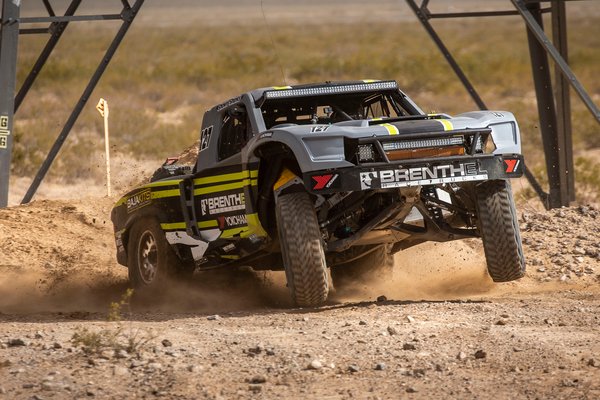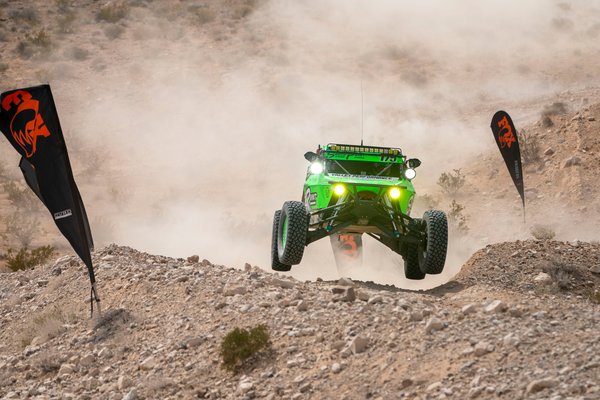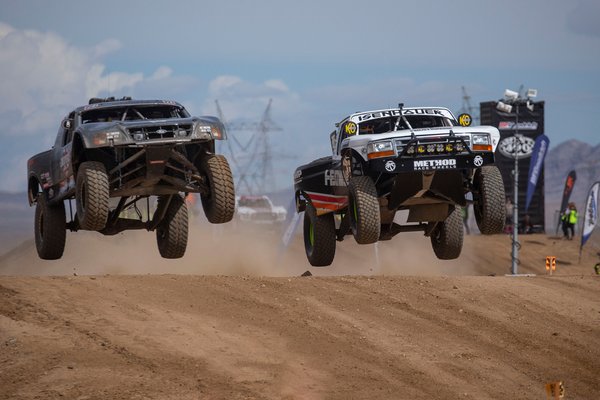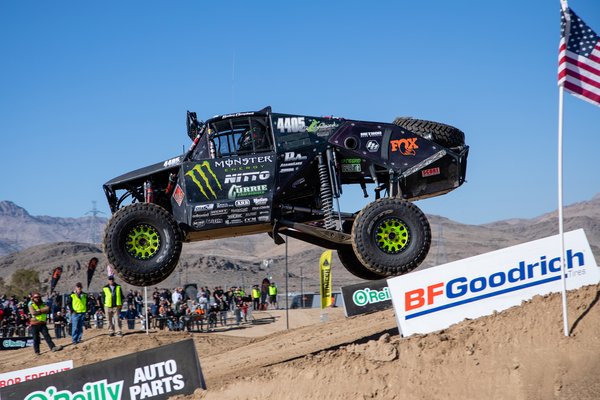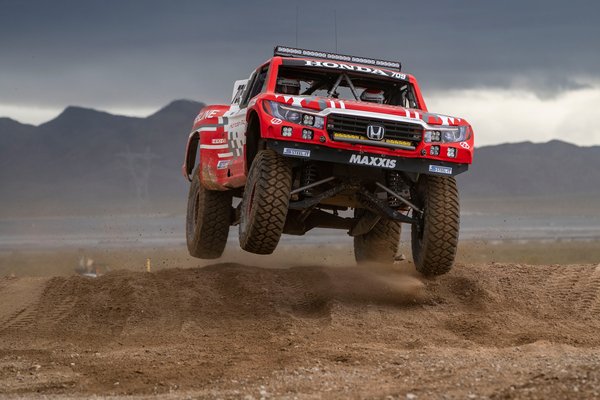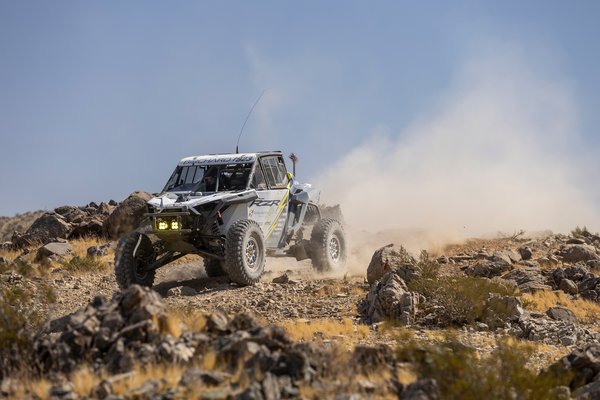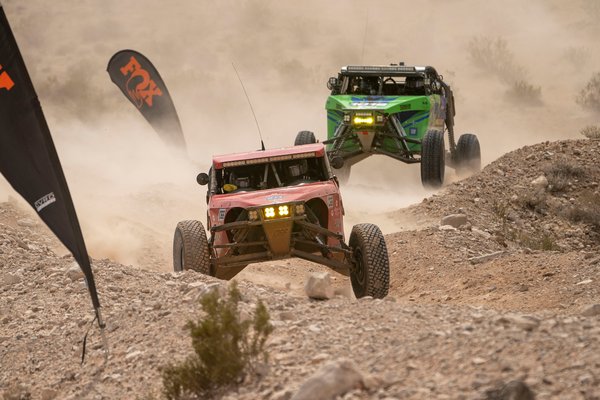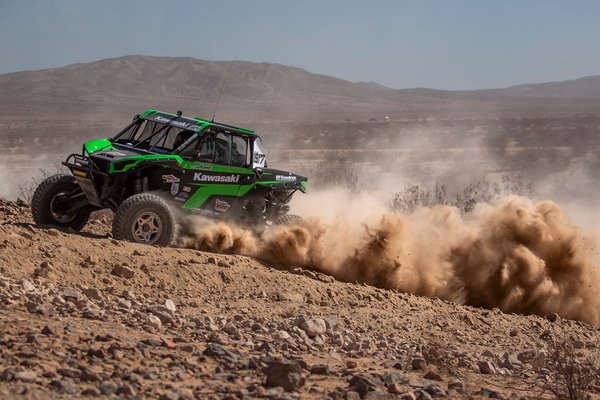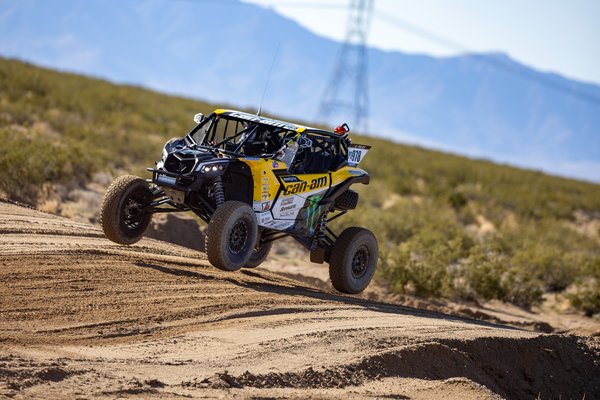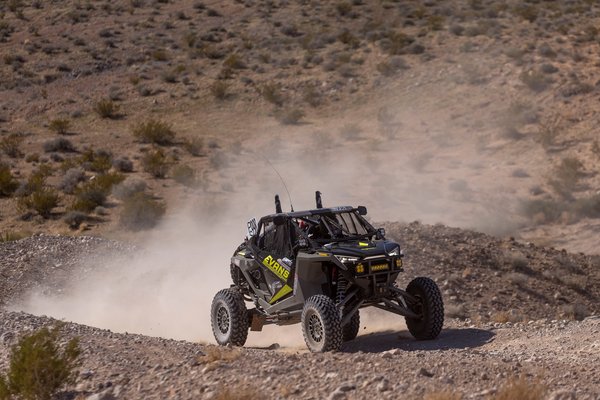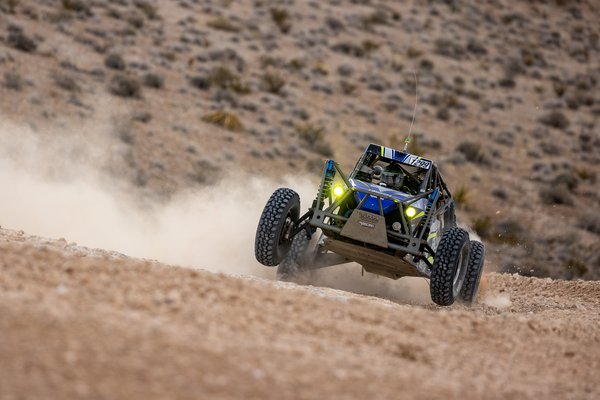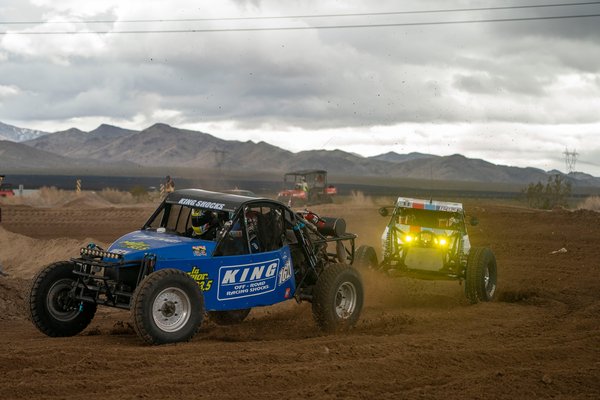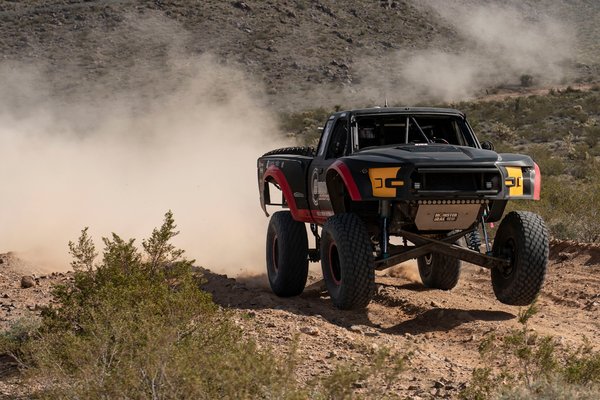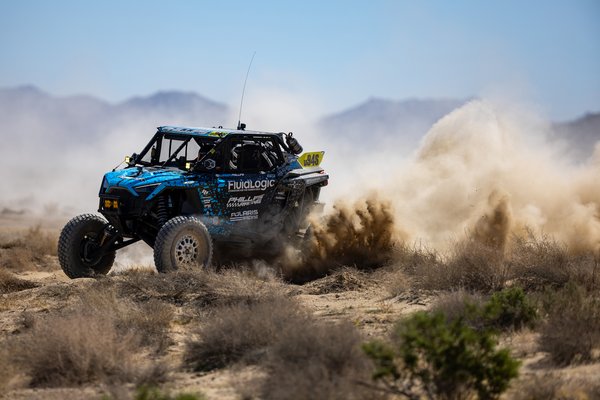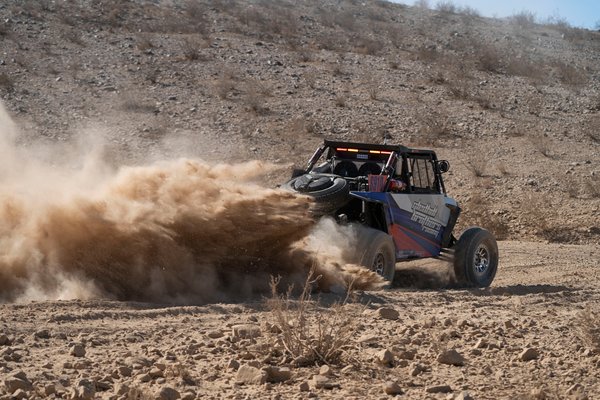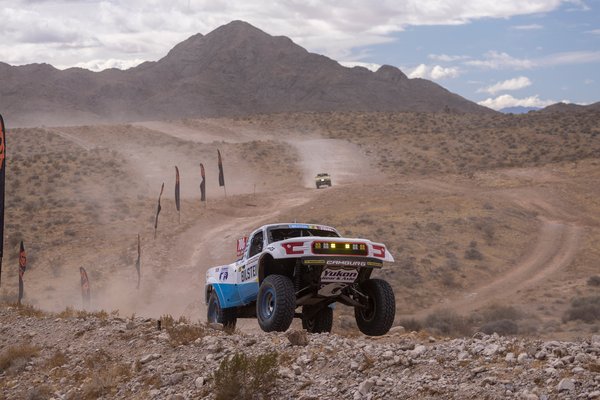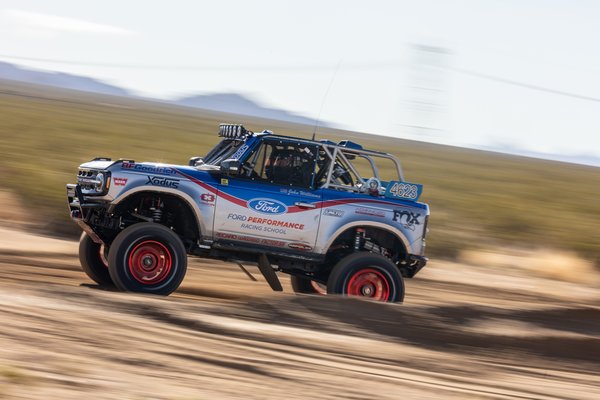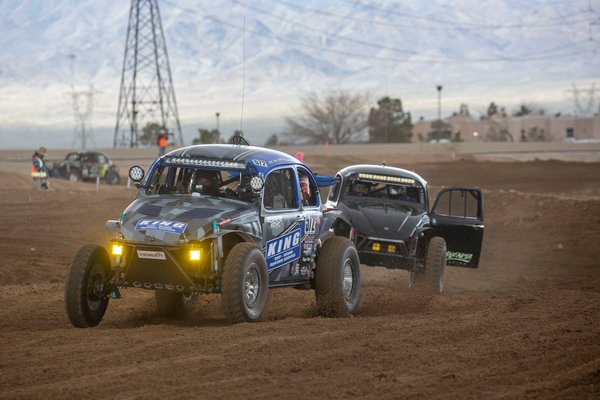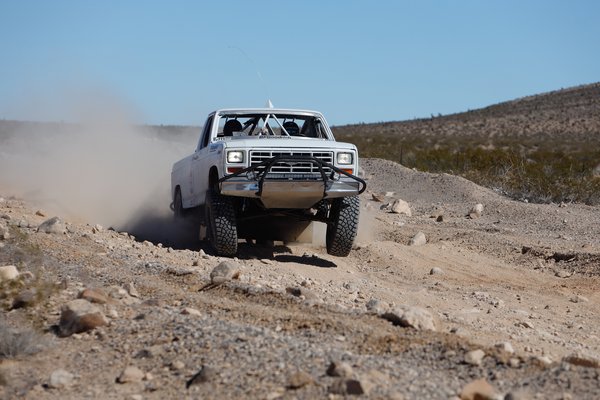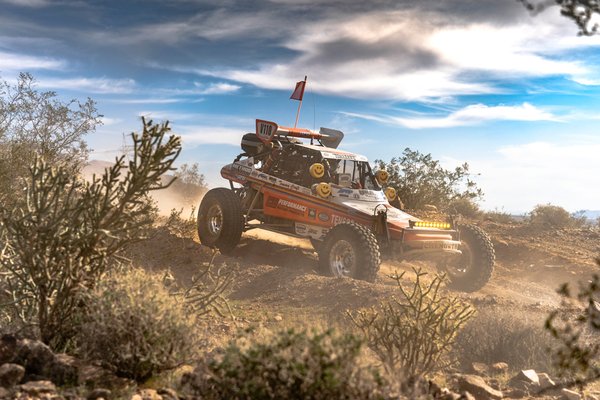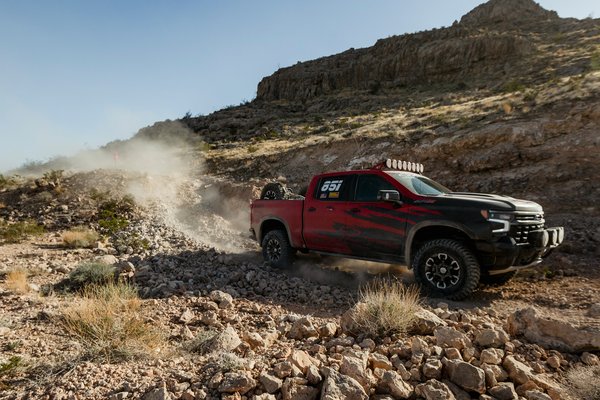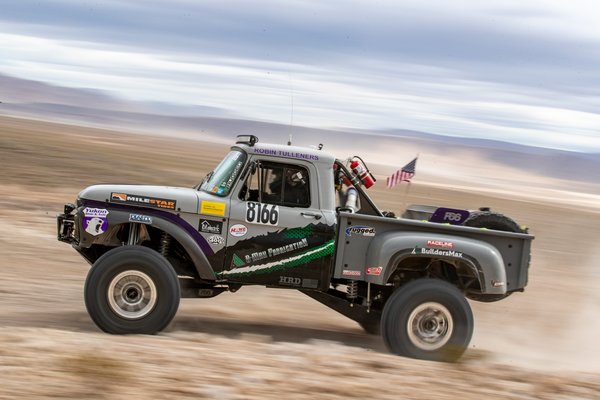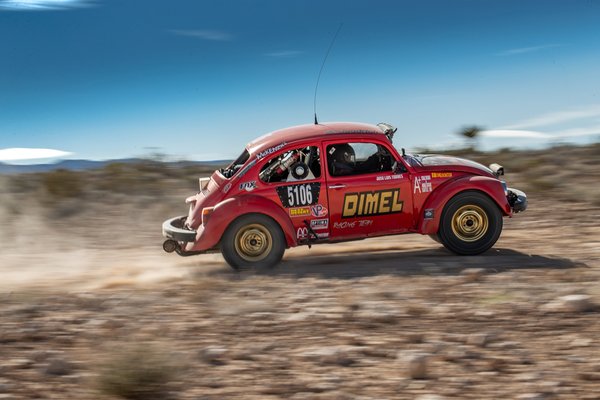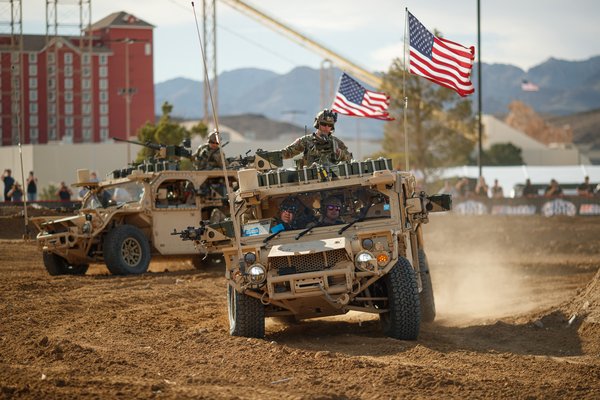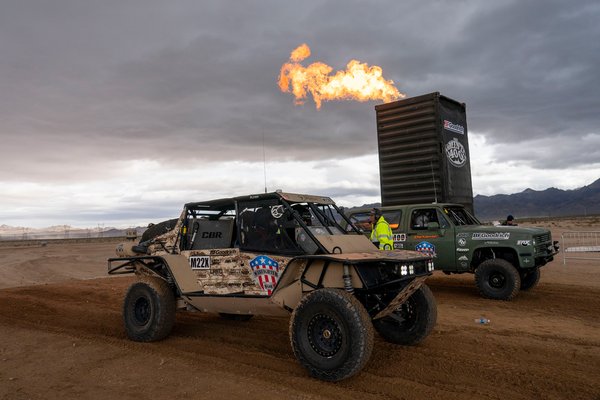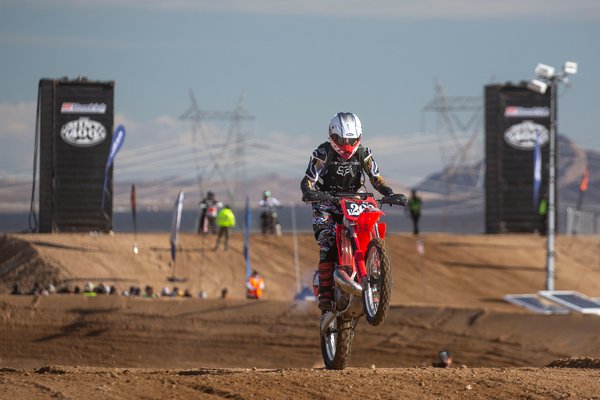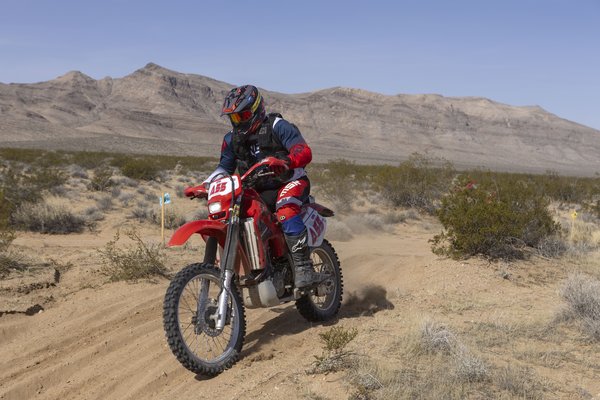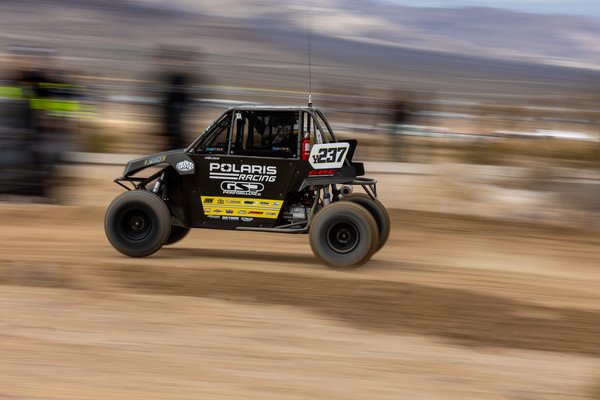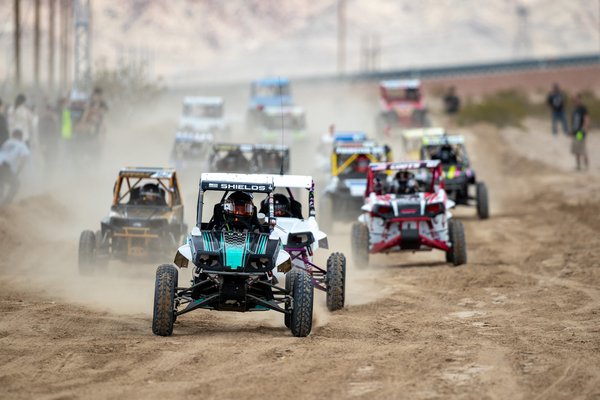2026 American Off-Road Racing Championship Rulebook
The American Off-Road Racing Championship (“AORC”) General Rules are the exclusive property of AORC, jointly administered by Unlimited Off-Road Racing and Best in the Desert Racing Association. Any publication, distribution, reproduction, or use of these Rules by other organizations or individuals is prohibited without AORC’s prior written consent.
These Rules set forth the regulations, policies, specifications, and minimum requirements governing the conduct of, and participation in, all AORC-sanctioned events. They are intended to enable professional administration and establish minimum standards for safety, fairness, and competition.
Participation in AORC events is voluntary. By entering, competitors, team members, officials, and other participants agree to be bound by and comply with all applicable AORC rules and directives. It is each participant’s responsibility to read, understand, and comply with the Rules; failure to be familiar with the Rules will not excuse non-compliance.
AORC rules are organized from broad to specific:
- General Regulations: Apply to all persons and activities at AORC-sanctioned events.
- Technical Regulations: Published separately; govern equipment, construction, safety systems, and technical procedures by broad vehicle category (e.g., Car/Truck, UTV, Motorcycle/Quad, Youth). Note: These were previously called “Competition Regulations” by Best in the Desert.
- Class Regulations: Published separately; govern class-specific eligibility and configuration requirements for the class a competitor elects to enter.
- Event Supplementary Regulations (“SRs”) & Official Bulletins: Event-specific instructions and season updates/clarifications issued by AORC. Once published, SRs and Bulletins carry full authority and must be observed. Note: If a conflict arises, SRs/Bulletins may supersede the General, Technical, and/or Class requirements. Where safety is implicated, the more restrictive requirement applies.
Rule Hierarchy & Precedence:
These General Rules apply to all AORC-sanctioned activities. In the event of any conflict among AORC regulations, the following order of precedence governs for the affected Event:
- Event Supplementary Regulations and Official Bulletins (most specific)
- General Regulations
- Technical Regulations / Competition Regulations
- Class Rulebooks
2026 AORC General Regulations:
Below are the 2025 UNLTD General Regulations for reference. 2026 American Off-Road Racing Championships General Regulations will be posted soon...
Please note - The General Rules listed below are from the 2025 UNLTD Off-Road Racing rulebook.
UNLTD Off-Road Racing and Best in the Desert are currently working on the 2026 American Off-Road Racing Championship General Rules.
INTRODUCTION
The Unlimited Off-Road Racing Rulebook is the exclusive property of The Unlimited Off-Road Racing Race Corp. The publication, distribution, and/or use of these rules by another organization or individual is strictly forbidden unless prior written consent is given by The Unlimited Off-Road Racing Race Corp. owners.
This Rulebook contains rules, regulations, policies, specifications, and technical requirements overseeing the operations of, and participation in, the Unlimited Off-Road Racing off-road races. It is being published to provide for the professional conduct of The Unlimited Off-Road Racing racing events and to establish the minimum acceptable safety requirements for such events. The Unlimited Off-Road Racing owners reserve the right to alter, suspend or update this Rulebook, and/or issue additional regulations, at any time with or without notice, and at their sole discretion.
This Rulebook contains both a general set of Unlimited Off-Road Racing race competition rules, as well as vehicle specific rules that govern each class. It is mandatory that every Unlimited Off-Road Racing race participant (owners, builders, drivers, co-drivers, pit crews, etc…) know these rules and adhere to them strictly or face penalties, possible disqualification and/or removal from the races if at any time, especially if their actions are deemed unsafe.
Ignorantia juris non excusat. The rules, regulations, policies, specifications, and technical requirements governing the conduct of, and participation in, the Unlimited Off-Road Racing shall be deemed in effect at all times, regardless of whether or not any Unlimited Off-Road Racing Race Participant has knowledge of them.
LIABILITY
All Unlimited Off-Road Racing Participants hereby acknowledge that operating an off-road vehicle for any purpose, and especially for the purpose of high-speed competition, is inherently dangerous and presents a significant risk of personal property damage, personal injury and/or death - at all times.
All Unlimited Off-Road Racing Participants assume any and all risks associated with using any/all information presented in this Rulebook, including the use of head, neck and body restraint or other safety systems, or participating in any way in The Unlimited Off-Road Racing Race event, whether those risks are known or unknown, inherent or otherwise.
The Unlimited Off-Road Racing Race Corp, its members, officers, directors, or staff, assume no responsibility, legal, or otherwise, for failure or defect of any products of manufacturers listed in this Rulebook
The technical specifications and safety standards presented in this Rulebook are intended for use as a guide with respect to safety and for no other reason, either expressed or implied.
The Unlimited Off-Road Racing Race Corp. assumes no responsibility for decisions made by individuals using this rulebook. The use of these Rules by any association, or organization, manufacturer or individual is voluntary. The Unlimited Off-Road Racing Race Corp. does not accept responsibility for consequences resulting from their application.
Force Majeure. The Unlimited Off-Road Racing assumes no responsibility whatsoever for delays, postponements or cancellations of all or part of an event for any reason, including inclement weather, acts of God, or unsafe course conditions.
The Unlimited Off-Road Racing event participants, officials, and volunteers are not employees of The Unlimited Off-Road Racing Race Corp. and are solely responsible for any taxes, premiums or other charges resulting from prizes awards or giveaways earned by Participants, officials, volunteers, or staff.
OVERVIEW
The Unlimited Off-Road Racing Rulebook is intended as a guide for the conduct of The Unlimited Off-Road Racing Race only and is in no way a guarantee against injury or death to Participants, spectators, or employees. No express or implied warranty of safety shall result from publication of or compliance with these rules and/or regulations.
The Unlimited Off-Road Racing Race and events are private. The Unlimited Off-Road Racing Race Corp. reserves the right to refuse entry to any applicant, team, competitor, entrant, participant, or any other person, to any event for any reason.
The Unlimited Off-Road Racing Race Corp. and its staff, agents and volunteers are not professional safety equipment makers, professional designers, fabricators, or equipment installers and this Rulebook is published without warranty expressed or implied. Compliance with this Rulebook does not imply or guarantee any Participant against property loss or damage or injury, or death.
Unlimited Off-Road Racing Race Participants shall at all times exercise sound judgment and the highest level of sportsmanship, and are responsible for their own safety and bodily well-being at all times, regardless of any of the Rules or Regulations contained herein. Nothing in this Rulebook shall be construed as The Unlimited Off-Road Racing Race Corp accepting liability for bodily injury or property damage by one Race Participant to another, or spectator or employee.
Specifications and standards for equipment established in this Rulebook, particularly safety standards, are the minimum requirements. Nothing in this Rulebook should be interpreted to prevent teams or participants from utilizing greater safety mechanisms or establishing stricter safety standards than the minimums required, so long as they do not conflict with other rules published in this rulebook.
This Rulebook and the information contained herein is NOT intended to be professional, advice on how to design, build, fabricate, install or use any vehicle, component, part, device, system, or piece of equipment, including safety systems.
Nothing in this Rulebook shall be construed to override local, state and federal law. Unlimited Off-Road Racing Race Participants shall at all times obey local, state and federal laws and comply with any request by Las Vegas Metro Police, Las Vegas Sheriffs, Bureau of Land Management staff including any BLM Law Enforcement Officers, Unlimited Off-Road Racing Owners, the Unlimited Off-Road Racing Race Director, The Unlimited Off-Road Racing Safety Director, The Unlimited Off-Road Racing Medical Director, and any Unlimited Off-Road Racing Ranger.
All Unlimited Off-Road Racing Race Participants, spectators, and employees, including the reader of this Rulebook, hereby agree to waive, and release, and relinquish, and protect, and hold harmless / indemnify and defend the promoters, race operators, and The Unlimited Off-Road Racing Race Corp., including their successors, and heirs, and officers, and officials, and staff/employees, and agents, and contractors, as well as their respective insurance companies, and successors in interest, sponsors, agents, employees, representatives, assignees, officers, directors, and shareholders of and from any and all claims, demands, liabilities, losses, costs, or damages or expense for any other loss or damage arising, or alleged to have arisen, from any use of any information contained in this Rulebook or by reason of any inaccurate or incomplete information, omission of information, or any negligent act in or related to this Rulebook.
DEFINITIONS AND GENERAL INFORMATION
TERMINOLOGY DEFINITIONS
The terminology, definitions and abbreviations contained herein shall be used in The Unlimited Off-Road Racing rulebook, supplementary rules, entry forms, and newsletters and for general use.
RULE USAGE
The Unlimited Off-Road Racing PROMOTION
Any and all racing related events fully produced by The Unlimited Off-Road Racing.
The Unlimited Off-Road Racing CO-PROMOTION
Another promoter working with The Unlimited Off-Road Racing to promote an event.
The Unlimited Off-Road Racing SANCTION
The documentary authority to organize and conduct an event as granted by The Unlimited Off-Road Racing.
ORGANIZATION TERMINOLOGY
Unlimited Off-Road Racing
The promoter/sanctioning body.
EVENT
A contest between one or more vehicles competing against the clock.
CLASS
A class is a category of vehicles as determined by seating capacity, engine size, suspension type, or any other method listed in this The Unlimited Off-Road Racing rulebook. Classes may be combined at the discretion of The Unlimited Off-Road Racing.
Pro class entrants will be eligible to receive points, trophies, contingencies, and monetary awards in respect to their finishing position.
Sportsman class entrants will be eligible to receive trophies and contingencies only in respect to their finishing position. They may receive monetary awards at the discretion of The Unlimited Off-Road Racing.
ENTRANT
An Unlimited Off-Road Racing member whose entry is accepted for an event.
AGE REQUIREMENTS:
Car/Truck/UTV’s: Minimum age for drivers in any Car/Truck class is 14 years old. Must be 14 by the date of the event.
Motorcycles: Minimum age for riders in any Motorcycle class is 16 years old. Must be 16 by the date of the event.
Youth: Age restrictions on all youth classes are set from the first race day of the first event of the season.
DRIVER OF RECORD
The person listed on an official The Unlimited Off-Road Racing entry form to be the main operator of a vehicle entered in an event. The driver of record must sign all entry and release forms in person during the normal registration time in order to be eligible for points, prize money, and contingency awards in that event. Identification may be required during registration. Special consideration registration may be permitted with advanced approval of The Unlimited Off-Road Racing. Driver of Record is responsible for all actions of his/her team, pit crew and/or anyone associated with the Driver of Record / race vehicle number.
CO-DRIVER
A person listed on an official The Unlimited Off-Road Racing entry form as a cooperator of a vehicle that is eligible to drive or ride during the course of the race. The co-driver must sign all entry and release forms in person during the normal registration time at the same time as the driver of record is signing all entry and release forms. Identification may be required during registration. Special consideration registration may be permitted with advanced approval of The Unlimited Off-Road Racing.
CONTESTANT
A person listed on an official The Unlimited Off-Road Racing entry form to compete in a race as either a driver or co-driver.
OFFICIALS
RACE DIRECTOR
Responsible for all race events of the organization. The head judicator and referee of the races. All other officials report directly to the Director. The Director has the final decision on all issues involving any of The Unlimited Off-Road Racing race events. The Director has full discretion to make any final determinations, judgments or penalties in relationship to all The Unlimited Off-Road Racing rules and/or regulations.
OPERATIONS MANAGER
The second in command. Responsible for helping plan, organize and supervise the on-course conduct of all race events, and carrying out other responsibilities as assigned by the Director. In the absence of a Director, the Operations Manager will assume all the Responsibilities of the Director.
TECHNICAL DIRECTOR
The race official appointed by The Unlimited Off-Road Racing to direct the inspections of entrant's vehicles before and after each event, for technical and safety compliance with The Unlimited Off-Road Racing's rulebook. Decisions adjudicated by the Technical Director will be final.
ASSISTANT TECHNICAL DIRECTOR
The race official appointed by the Technical Director and The Unlimited Off-Road Racing to assist the Technical Director. The Assistant Technical Director shall perform all duties of the Technical Director in the event the Technical Director is not available. The Technical Director shall carry out all other duties as assigned by the Director and / or Technical Director.
SCORING DIRECTOR
The race official appointed by The Unlimited Off-Road Racing to direct the timing and scoring operations of a race event.
COMMUNICATIONS DIRECTOR
The race official appointed by The Unlimited Off-Road Racing to direct the radio, cellular, and internet based communications networks used for the events and races.
RACE OFFICIAL
All individuals designated by the Director or Operations Manager to officiate at The Unlimited Off-Road Racing races.
COURSE MARSHALS
The race officials appointed by The Unlimited Off-Road Racing to assist the Operations Manager in the on-course conduct of a race event.
CHECKPOINT CAPTAIN
A race official appointed by The Unlimited Off-Road Racing to direct the operations of their checkpoint and the immediate area around the checkpoint.
PAVED ROAD CROSSING CAPTAIN
A race official appointed by The Unlimited Off-Road Racing to direct the operations of their paved road crossing and the immediate area around the paved road crossing
PIT STOP CAPTAIN
A race official appointed by The Unlimited Off-Road Racing to direct the operations of their pit stop and the immediate area around the pit stop.
STARTER
The person responsible for starting any of the Unlimited Off-Road Racing races, by displaying the appropriate flags and/or lights, as directed by the Operations Manager.
EVENT TERMINOLOGY
SUPPLEMENTARY REGULATIONS
Regulations that define special or additional rules for a specific event, and/or technical or class rule changes.
IMPOUND
A specific place with restricted access designated for the containment of all race vehicles immediately before and/or after an event.
CONTINGENCY
A contingency is the commitment made to The Unlimited Off-Road Racing by verbal or written contract with a manufacturer, company or individual to post or pledge a certain amount of cash or product as an award to contestants. Contestants must apply for, be approved by and meet requested requirements as set by the manufacturer, company or individual posting the contingency. Decals are generally required and must be assumed to be required unless otherwise stated. Unless otherwise stated the contestant must finish the event in order to be eligible.
PAYBACK
The share of the purse that an entrant receives for finishing a race in a paying position. Only actual finishers qualify for a share of the monetary purse. For 2020 and beyond the Unlimited Off-Road Racing has elected not to use a Payback system, but rather to offer purses to classes with 5 or more entrants. In general these purses will be made public prior to race day.
RULES ABBREVIATIONS
UGR: GENERAL RULES
UGE: ENTRANTS
UGD: DISQUALIFICATION
UEC: EVENT COURSE
UGP: PROTESTS
UIP: INFRACTION PENALTIES
UDC: DRIVER / RIDER, CO-DRIVER / CO-RIDER
UGPT: PITS
UGT: TECH-INSPECTION and IMPOUND
UCR: COMPETITION REGULATIONS
GENERAL RULES
UGR1: Off-road racing is a dangerous motorsport by nature. As such, no entrant, pit crew member or vehicle sponsor shall have any claim for damages, expenses, lawsuits or otherwise against the owners, sanctioning bodies, promoters, track builders, race operators, The Unlimited Off-Road Racing officers, agents or directors arising from damage to any vehicle, personal injury or death, or monetary loss of any kind whatsoever. All entrants, pit crew members or vehicle sponsors who voluntarily participate in any racing activities conducted under these rules, waive any claim they may have against the owners, sanctioning bodies, promoters, track builders, race operators, The Unlimited Off-Road Racing officers, agents, vendors, employees, volunteers or directors.
UGR2: The promoters or Race Director may run any type of racing for The Unlimited Off-Road Racing event and races.
UGR3: The Race Director or Operations Manager shall have the authority to penalize, disqualify and/or suspend any entrant or crewmember for the violation of these rules, including special rulings and supplementary regulations.
UGR4: The Unlimited Off-Road Racing may issue special rulings to account for conditions presented by the location of the race, the condition of the course or any other circumstance such as inclimate weather.
UGR5: Special rulings and specifications will be considered as official amendments to the list of rules and regulations when issued by The Unlimited Off-Road Racing in written form in official The Unlimited Off-Road Racing publications.
UGR6: Supplementary regulations may be issued for each race event as necessary to amend, suspend or modify existing rules and regulations. Supplementary regulations will be considered official when published to the Unlimited Off-Road Racing website.
UGR7: The Unlimited Off-Road Racing assumes no responsibility whatsoever for delays, postponements and/or cancellations of all or part of an event because of inclement weather, unsafe course conditions and/or any other reason.
UGR8: The Race Director and Operations Manager will have the responsibility for the conduct of any race event conducted under these rules. All official race personnel will be directly responsible to the Race Director or Operations Manager.
UGR9: The Race Director or Operations Manager shall have the authority to penalize any entrant (up to and including disqualification and/or suspension) found to have committed violations of driver’s rules and/or conduct.
UGR10: No one falling under the jurisdiction of any race officials at any Unlimited Off-Road Racing event shall subject said officials to foul language, physical abuse, threats, intimidation, or any other demeaning action.
UGR11: The Unlimited Off-Road Racing race entrants, participants, and volunteers, are not employees of The Unlimited Off-Road Racing. Unlimited Off-Road Racing entrants assume all responsibility for taxes payable on any monies they may receive as a result of their participation in The Unlimited Off-Road Racing races.
UGR12: The Unlimited Off-Road Racing reserves the right to refuse and/or deny any entry application for any reason without discussion.
UGR13: The Unlimited Off-Road Racing uses the frequency of 151.625Mhz as a main race channel for drivers and teams to communicate to us. The Unlimited Off-Road Racing reserves the right to change the main race channel frequency if deemed necessary. The Unlimited Off-Road Racing will make all reasonable efforts to notify all entrants of the new frequency. All radio or other transmissions, which affect The Unlimited Off-Road Racing control communications, are strictly prohibited except in the case of medical emergencies.
UGR14: The checkpoint captains are the direct representatives of the Operations Manager at their respective checkpoints. Their area of responsibility includes 50 yards on either side of the checkpoint.
UGR15: Checkpoint captains will designate areas leading to and surrounding the checkpoint area. This area is for checkpoint personnel only. No support teams, pit crews, chase crews or any other person without expressed permission will be permitted in this area. Failure to comply will subject the entry to penalties of up to and including disqualification.
UGR16: Classes may be combined at the discretion of The Unlimited Off-Road Racing.
UGR17: The Race Director, Operations Manager and or Chief Technical Inspector shall have the authority to penalize, disqualify and/or suspend any entrant for violations of vehicle technical rules.
UGR18: The Race Director has the final decision on all issues involving any Unlimited Off-Road Racing race events. The Race Director has full discretion to make any final determinations, judgments, suspensions or penalties in relation to all Unlimited Off-Road Racing rules and/or regulations.
ENTRANTS
UGE1: Any entrant who fails to properly fill out and sign required entry forms and releases shall be disqualified and shall forfeit any prize money, points and contingencies won in that particular event. Entry forms and releases must be signed in person in front of Unlimited Off-Road Racing registration personnel. Identification may be required.
UGE2: The entry applications of persons under the age of 18 must have a parent or legal guardian sign the release form.
UGE3: No entrant may enter racing areas until they have signed all releases and/or entry forms. No person shall sign the release or entry forms for anyone other than himself or herself. Proper identification may be required (i.e., government issued ID).
UGE4: Any entrant who competes in a vehicle that he/she is registered to drive or co-drive must sign all of the official registration documents. If all documents are not signed with it may result in a vehicle disqualification.
UGE5: Deliberate abusive, nerfing or bumping shall be reason for penalty, disqualification and/or suspension at the discretion of the Race Director or Operations Manager.
UGE6: All drivers and co-drivers of record as listed on the official Unlimited Off-Road Racing entry form must attend all drivers/riders meetings, or provide a suitable member of their race team. Failure to do so may result in penalties of up to and including disqualification and/or fines. Wristband checks and written roll calls may be made at the meeting.
UGE7: If a driver of record change is made after the entrant has completed event registration, the starting position will be forfeited and the entrant will start at the rear of their class.
UGE8: A driver will not permit any other person other than a registered co-driver in the co-drivers normal riding position. The driver shall not permit anyone to ride on or in any part of his or her vehicle other than the normal riding positions.
UGE9: No entrant, crew member, pit personnel or any other person(s) other than the Race Director, Operations Manager or a Unlimited Off-Road Racing official shall remove, alter or relocate course markings. The person(s) found to have removed, altered or relocated course markings may be disqualified and/or immediately removed from the area and may be refused access to future Unlimited Off-Road Racing races and events.
UGE10: There is no pre-running at The Unlimited Off-Road Racing. Period. Anyone caught on the Unlimited Off-Road Racing racecourse pre-running after the maps/course have been published may be subject to time penalties, disqualification and/or monetary fines imposed by The Unlimited Off-Road Racing or the BLM.
UGE11: Failure to appear before the Race Director when requested may result time penalties, or disqualification.
UGE12: All Cars/Trucks competing at the Unlimited Off-Road Racing must display (2) of the supplied Unlimited Off-Road Racing stickers, (one on each side of the registered race vehicle), during the entire race. All motorcycles competing at the Unlimited Off-Road Racing must display (1) one of the supplied Unlimited Off-Road Racing stickers on their bike for the entire race. No other race league or race event stickers may be displayed on the race vehicles during tech, qualifying, or the race, i.e., stickers, emblems, etc. Unlimited Off-Road Racing stickers are required on all race vehicles for contingency and race payouts.
DISQUALIFICATION
UGD1: Drinking intoxicating beverages in the official pre-race technical inspection area and post race areas (i.e., impound area, etc.), pits, on the racecourse or in the surrounding areas by any person is strictly forbidden. The use of narcotics (amphetamines or any other stimulants, barbiturates or other depressants) is forbidden. Any entrant or crew member that shows any evidence whatsoever of being under the influence of alcohol or drugs shall be subject to suspensions from all future Unlimited Off-Road Racing races and events. Violators will be removed from the premises immediately at the direction of the Operations Manager or the Race Director.
UGD2: Any entrant who makes a false statement on an entry form shall be disqualified and shall forfeit all prize money, points and all contingencies won in the race. Entrant may also be suspended from future race events for a period of one year.
UGD3: Any entry application containing a falsified signature will cause entrant to be disqualified and shall forfeit all prize money, points and contingencies won in that race event. Entrant may also be suspended from future events for a period of one year.
UGD4: Any entrant disqualified from any race event for any reason whatsoever forfeits any and all rights to prize money, points and contingencies. Entrant will not be entitled to a refund of all or any portion of his/her entry fee.
UGD5: There is no outside assistance permitted on the Unlimited Off-Road Racing course or near the course during the event except for those Unlimited Off-Road Racing designated areas set-aside for pits and/or gas stops. The Unlimited Off-Road Racing retains the right to assess each situation and respond accordingly. (Situations involving safety are at the discretion of the Operations Manager or Race Director of The Unlimited Off-Road Racing .)
In the event that a vehicle breaks down on the course The Unlimited Off-Road Racing approves the following options. (Any deviation from these options may result in the entrant being disqualified.)
1) Driver or Co-driver who is with the vehicle at the time of breakdown may walk to and from the nearest official Unlimited Off-Road Racing pit, in order to retrieve equipment or parts necessary to repair the vehicle. Anyone other than the vehicle occupants that deliver equipment or parts will subject that vehicle to disqualification. Obtaining equipment or parts from any other location than an official Unlimited Off-Road Racing designated pit stop will subject entrant to disqualification.
2) Another race-entered vehicle may pick up equipment or parts at the previous designated pit stop and then deliver that equipment or parts to the broken down vehicle. The race vehicle picking up the equipment or parts must travel in the proper direction on the course. Traveling backwards on the course will subject both entrants to disqualification. Any pit support vehicle or other than race entered vehicle delivering parts to a broken down vehicle will subject entrant to disqualification.
3) Any Unlimited Off-Road Racing Official may assist any race entrant as long as it is done in a safe and controlled manner with permission from the Race Director, Operations Manager or Communications Director.
UGD6: Any race entrant or their support personnel who subject any Unlimited Off-Road Racing official, other race entrants or their support personnel to verbal threats and/or physical abuse will be brought before the Race Director. The Race Director will make the decision of disqualification and/or suspension of the driver/rider of record and the offending support personnel for said offenses. Acts of physical abuse may be reported to the proper authorities and may lead to legal action.
EVENT COURSE
UEC1: The Unlimited Off-Road Racing Race Director and Operations Manager will set the racecourse, its overall length, and determine the # of laps raced, allowable race time, pit closing times, and other important timings for each class at all race events.
UEC2: An entrant’s official time shall be the total elapsed time from their assigned starting time to the time they cross the official finish line. The elapsed time must be less then the official time length of the race. If an entrant does not report to the staging area in time to stage in their respective starting position, the entrant will be placed in the rear of their class. If the last of their class has already started, the entrant will be started in the next available position at the discretion of the Race Director. In all cases if the entrant does not start at their assigned time, their time will start from their assigned starting time, not their actual starting time.
UEC3: The winner of each class shall be the entrant that finished the race with the lowest elapsed time or the most laps within the event time limit. The entrant must also meet all other criteria in order to be declared the official winner. Penalties assessed by Pit Captains or course workers may affect the final standings of racers.
UEC4: All entrants must report all accidents and/or breakdowns they may have witnessed. Entrant must inform a Unlimited Off-Road Racing official at the next checkpoint, paved road crossing, pit stop or by radio, of the location, vehicle number, and injuries, if any.
UEC5: Two battery-operated red flashing beacons, two long glow sticks or two red reflective devices must be carried in the vehicle. Reflective devices must be at least 12 inches high and 12 inches long and be free standing (similar to trucker’s breakdown triangles). Beacons, glow sticks or reflective devices must be placed at least 200 feet and 20 feet behind any breakdown or accident and be placed beside the track on the same side of track as the vehicle.
UEC6: Passing is not permitted within 300 feet on either side of any paved road crossing or inside designated Pit Stop, except at the direction of a Unlimited Off-Road Racing official. Failure to comply, may result in a disqualification or a time penalty of 5 minutes for each occurrence at the discretion of the Race Director.
UEC7: Any entrant who must discontinue the race must report themselves or via their team on radio frequency 151.625, or to a checkpoint, paved road crossing, pit stop or start/finish Official that they are out of the race.
UEC8: The Unlimited Off-Road Racing staff will monitor all team aircraft communications. Aircraft are permitted for the purpose of race support, however radio communications are to be used for safety purposes ONLY. Communication with race vehicles, pit support vehicles or pits; ie…”spotting” for race vehicles is not permitted unless and except for notification of dangers posed by other racers or race conditions. Transportation of drivers/riders and or support crews (unless a medical emergency exists); transportation of equipment and/or parts; landing on or near the racecourse, or in any areas other than the Jean Airport; and/or flying too low, especially over spectators or pits; and/or interfering with the normal conduct or actions of the event are STRICTLY FORBIDDEN and WILL result in disqualification. Any team utilizing an aircraft or hiring an aircraft for media documentation or observation must adhere to the published Unlimited Off-Road Racing Rules and Regulations.
Requests for aircraft special use (i.e.: filming, observing, etc.) must be submitted to The Unlimited Off-Road Racing prior to the races via digital signup on the official Unlimited Off-Road Racing website. Requests must include the radio frequencies (helicopter or airplane frequency and race team frequency) to be used and must be submitted no later than one week prior to scheduled race event. Any request received during the week prior to the event may not be considered. All registered pilots or a suitable substitute must be present at the helicopter / aircraft safety meeting.
UEC9: Starting procedures will be announced at the drivers/riders meeting.
UEC10: Every vehicle must leave the start line at its designated start time. Only those vehicles that cross the finish line within the designated time limit will be declared official finishers. Every vehicle must come to a complete stop and pass through all checkpoints and pit stops. Failure to stop and pass through all checkpoints along the course will subject that entry to penalties of up to and including disqualification at the discretion of the director or operations manager. Every vehicle must come to a complete stop at all designated paved road crossings. Failure to stop at all designated paved road crossings along the course will subject that entry to penalties of up to and including disqualification at the discretion of the Race Director or Operations Manager.
UEC11: All vehicles must enter each stop checkpoint or paved road crossing at a safe speed. Unsafe racing into and/or through any stop checkpoint or paved road crossing is prohibited. Speeding through a stop checkpoint or paved road crossing is grounds for an automatic disqualification. Rolling through a stop checkpoint, pit stop or paved road crossing is a minimum five-minute time penalty for each occurrence. Safe speed is defined as a speed at which a vehicle may make a controlled stop without endangering anyone within the immediate vicinity of the checkpoint, paved road crossing or pit areas.
UEC12: All entrants may be checked for their wristband at the Start Line or Finish Line and all vehicles may be checked for the technical inspection sticker at any or all checkpoints or pit stops. Every entrant is responsible for his/her wristband and vehicle technical inspection sticker. Any entrant found not to have a wristband or vehicle without a technical inspection sticker may cause that vehicle to be disqualified.
UEC13: No vehicle shall be towed, pushed, pulled or transported by any non-race-entered vehicle on the official course, except by the Unlimited Off-Road Racing official retrieval crew. Another race entered vehicle or an official Unlimited Off-Road Racing vehicle may push, pull or tow the race-entered vehicle up to the nearest pit stop or checkpoint but may not push, pull or tow it through the pit stop. Occupants of the vehicle that is pushed pulled or towed to that point must make necessary repairs in order to leave that area under their own power. No vehicle may be pushed, pulled or towed by another vehicle within the last two-hundred yards (200 yards) of the finish; only the vehicle occupants at the time of the breakdown may push the vehicle through the finish line. No other person or persons will be permitted to assist in pushing, pulling or towing the vehicle. Unlimited Off-Road Racing officials may lend assistance to any race vehicle or the vehicle occupants in any manner they deem reasonable, such as retrieving the vehicle, pulling the vehicle, shuttling parts, tools/equipment, etc.
UEC14: No entrant registered as the Driver of Record may run in more than one class with the one vehicle even though entries are paid in more than one class. No individual may be registered as the Driver of Record for more than one vehicle in the same class.
UEC15: A marked course is that official route designated by and marked with official Unlimited Off-Road Racing markings. All vehicles must follow this route during the event. No vehicle may deviate from the marked course at any time unless the course is wide enough to pass. Passing is only permitted where there is no vegetation on the side of the course.
Short coursing is not permitted and could result in a time penalty or disqualification. Short coursing is defined as any deviation from the marked course for any reason other than passing. No deviation from marked course including passing is permitted in sensitive areas. Deviation from the marked course in these areas could result in disqualification. Sensitive areas are those which are marked by Unlimited Off-Road Racing markings and DQ signs.
Unlimited Off-Road Racing is not responsible for markings that are damaged or removed. All vehicles must drive only in the correct direction of the course route or trail. Driving backwards on the racecourse at any time is prohibited. Driving backwards on the course is grounds for penalties of up to and including disqualification and/or suspension.
Virtual Check Points (VCPs) may be placed along the race course to ensure there is no course cutting. Vehicles must come within 50’ of all VCP’s.
UEC16: A podium finish is 1st, 2nd and 3rd place.
PROTESTS
UGP1: The Race Director, Technical Director, or Operations Manager, with or without protest, has the right to penalize, fine, disqualify, and/or suspend any vehicle or entrant for violation of any of the Unlimited Off-Road Racing rules. Another entrant within the same class may make technical protests as the entrant being protested. A five hundred dollar ($500) cash fee must accompany protests for each item protested. The protest must be in writing along with the fee and be delivered to the Technical Director no later than 30 minutes after the official end of time limit. If the protest is proved valid the $500 fee will be returned to the protestor. If the protest is proved invalid the $500 goes to the person who was protested. Protests considered by the Technical Director that shows a lack of sportsmanship may not be accepted. The Technical Director will check the protested items. The decision of the Technical Director will be final. Interpretation of all rules along with violations and penalties thereof are at the discretion of the Unlimited Off-Road Racing. Penalties levied at the discretion of The Unlimited Off-Road Racing are final.
UGP2: Any entrant who has an official protest lodged against his/her race vehicle must submit to an inspection of the protested items. Failure to submit to inspection will result in automatic disqualification and/or suspension. Those attending the inspection(s) will be as follows:
A. The protester or their designated representative.
B. The protested competitor or their designated representative.
C. The protested competitor’s mechanic.
D. Unlimited Off-Road Racing officials.
E. The Unlimited Off-Road Racing Technical Director who shall supervise the required inspection of the protested items(s).
F. No other persons shall be present nor witness the proceedings until the inspection has been completed.
UGP3: A complaint filed for improper driving or conduct does not require a cash fee. The complaint must be filed in writing with the operations manager or director no later than 30 minutes after the official time limit of the event. A complaint may be verbally filed by radio to any Unlimited Off-Road Racing official if the entrant filing the complaint is broken down on the track. The official will notify the Operations Manager or Race Director of the complaint. The entrant against whom the complaint is filed will be held in impound until complainant arrives at the impound area. The complainant must make every effort to arrive at the impound area within one hour after the official end of the event.
INFRACTIONS & PENALTIES
UIP1: The following legend of infraction penalties is a guideline used by The Unlimited Off-Road Racing in accessing penalties. These guidelines are not meant to infer that these are the only possible infractions or penalties that may be assessed against any entrant.
A. Failure to appear before the Operations Manager and/or Race Director when requested: Letter of reprimand and infraction penalty.
B. Rolling through a stop checkpoint (i.e. failure to come to a complete stop): Five minute time penalty each occurrence.
C. Speeding through and/or unsafe racing up to or through a pit/stop checkpoint: Disqualification.
D. Race vehicle traveling on the racecourse in the reverse direction of the race, before the official end of the event: Disqualification.
E. Pits (stationary, roving or chase) located in any areas other than those areas officially recognized as pit areas as designated by the Unlimited Off-Road Racing: Disqualification.
E2. Pit support vehicles traveling on the racecourse before the official end of event: Disqualification.
F. Minor nerfing: One position.
G. Major nerfing: Disqualification.
H. Abusive conduct toward a race official: Disqualification, suspension, one hundred dollar ($100) fine or any combination of the three.
I. Short coursing: Disqualification.
J. Stationary pits or chase crews outside of designated areas or traveling in restricted areas: Disqualification.
K. Reckless driving in pit areas or any access roads by race vehicle or race support vehicles: Disqualification.
L. Speeding in a restricted speed area up to 10mph over announced or posted speed limit by race vehicle or race support vehicles: One position.
M. Speeding in a restricted speed area over 10mph over announced or posted speed limit by race vehicle or race support vehicles: Disqualification.
N. Any combination of two or more infractions at any one Unlimited Off-Road Racing race: Disqualification.
O. Rolling through a paved road crossing (i.e., failure to come to a complete stop): Five-minute time penalty each occurrence.
P. Speeding through and/or unsafe racing up to or through a paved road crossing: Five- minute Time Penalty or Disqualification.
Q. Driver of Record is responsible for all actions of his/her team, pit crew and/or anyone
associated with the Driver of Record / race vehicle number.
R. Each missed VCP is a minimum 15 minute penalty.
UIP2: The Race Director or Operations Manager has the final decision on all issues involving any Unlimited Off-Road Racing race. The Race Director has full discretion to make any final determinations, judgments, suspensions or penalties in relation to all Unlimited Off-Road Racing rules and/or regulations.
DRIVERS — CO-DRIVERS
UDC1: Each seat in any race vehicle must be occupied during the entire duration of the event as long as the vehicle remains in competition. The maximum number of seats allowed in any Class is three (3). Seating must be designed in such a fashion to allow all passengers a quick exit and must meet with Unlimited Off-Road Racing approval.
UDC2: The driver of record must sign all entry forms and releases during the registration period to be eligible for points during that event. Identification may be required. Special consideration registration may be permitted with advanced approval of The Unlimited Off-Road Racing .
UDC3: Only entrants that are listed on official Unlimited Off-Road Racing entry form may drive or co-drive in the vehicle for which they are registered. In the event of an emergency, any registered arm-banded racer may get in any race vehicle, but the registered racer must notify a Unlimited Off-Road Racing race official. Registration is limited to a maximum of four entrants per vehicle.
UDC4: The Unlimited Off-Road Racing reserves the right to change race vehicle numbers and/or background colors.
UDC5: Driver of Record must start or finish the race, must be registered to the race vehicle and must have signed all of the releases required by the Unlimited Off-Road Racing. The Driver of Record will be given a “Driver of Record” wristband at onsite registration that must be worn by the Driver of Record and presented at the start OR finish of the race. Any team that fails to have their Driver of Record start or finish the race will result in a disqualification. An alternate driver may replace a Driver of Record racing for a points championship with a special exception approved by the Unlimited Off-Road Racing.
UDC6: The driver qualifying the race vehicle must start the race, must be registered to the race vehicle and must have signed all of the releases required by the Unlimited Off-Road Racing. The qualifying driver will be given an additional “Qualifying” wristband at onsite registration that must be worn during both qualifying and the start of your race. Any team that fails to have their banded qualifying driver at the start line will forfeit their start position and be moved to the rear of their class.
PITS
UGPT1: No vehicle will be permitted to enter pit areas or race area without a valid Unlimited Off-Road Racing pit pass, when required. Pit pass must be securely attached to front windshield and be clearly visible. The race-vehicle number must be clearly displayed on the side, front and rear windows (refer to UCR51).
UGPT2: All designated pits will be a MANDATORY STOP – NO PASSING ZONE - 25 MPH. At all times the driver of record assumes responsibility for the actions of their pit crew members, support crews, and all others associated with their team.
UGPT3: No person(s) under suspension by the Unlimited Off-Road Racing will be permitted to participate or be permitted to enter the pits or race area.
UGPT4: Any pit support vehicle running on or near the racecourse will result in the entrant being disqualified. Any pit support vehicle traveling in a restricted area will result in the entrant being disqualified. No pit vehicle may follow or lead a race vehicle on the racecourse. Any pit vehicle running backwards on the racecourse may cause the race vehicle to be disqualified. Any pit support vehicle stopping at a paved road crossing may cause a race vehicle to be disqualified. Any pit support vehicle stopping on a road that is near the racecourse and not in an official designated area may cause race vehicle to be disqualified. In the event that a vehicle breaks down on the course, the Unlimited Off-Road Racing approves the following options: (Any deviation from these options may result in the entrant being disqualified…)
1) Driver or Co-driver who is with a vehicle at the time of breakdown may walk to and from the nearest official Unlimited Off-Road Racing designated pit stop only, in order to retrieve equipment or parts necessary to repair the vehicle. Anyone other than the vehicle occupants that deliver equipment or parts will subject that vehicle to disqualification. Obtaining equipment or parts from any other location than an official Unlimited Off-Road Racing designated pit stop will subject entrant to disqualification.
2) Another race-entered vehicle may pick up equipment or parts at the previous official Unlimited Off-Road Racing designated pit stop and then deliver that equipment or parts to the broken down vehicle. The race vehicle picking up the equipment or parts must travel in the proper direction on the course. Traveling backwards on the course will subject both entrants to disqualification. Any pit support vehicle or any other non-race entered vehicle delivering parts to a broken down vehicle will subject entrant to disqualification.
UGPT5: Any entrant, crew member, or other pit pass holder who takes part in any demonstration in the pits, on the course, or surrounding area before, during or after an event shall be subject to expulsion from the area, suspension from future Unlimited Off-Road Racing events and possible legal action.
UGPT6: Maximum speed limit on all main pit access roads and in all pit areas will be 25mph for all vehicles. Maximum speed limit on all other access roads will be 25mph. The Unlimited Off-Road Racing reserves the right to change speed limits to account for conditions.
UGPT7: The Unlimited Off-Road Racing Pit Stop Captain shall determine the pitting zone around each pit stop.
UGPT8: All pit supplies must be at least 50 feet from the edge of the racecourse to the racetrack side of the race vehicle. No pit may be in the first 50 feet leading into and the first 100 feet leading out of a turn. Pits located within the turn area or less than 50 feet from the track will subject entrant to penalties of up to and including disqualification and or a minimum of one-hour time penalty at the discretion of the Race Director. Mandatory at all pits: some form of approved fuel containment mat under the vehicle when fueling. A tub or bucket to catch overflow is mandatory as well.
UGPT9: All pits regardless if fueling a vehicle during a stop are required to have at a minimum 2-10lb dry chemical or foam equivalent fire extinguishers out and ready for use. If fuel duties are being performed in that pit, including dump can use, you must have at a minimum 1- 20lb dry chemical or foam equivalent manned by a dedicated person during the fueling of the vehicle. Any team using an approved pressurized fuel filling system is required to have at a minimum 2 - 20lb dry chemical or foam extinguishers with one being manned by a dedicated team member for the duration of the stop. NOTE: For pressurized fuel system see UGPT13.
UGPT10: Young children, pets, fireworks, drones, RC cars, alcohol of any kind, smoking, and/or campfires or any open flames are not allowed in Unlimited Off-Road Racing pits! No exceptions!
UGPT11: All entrants are responsible for cleaning the pit areas they use during the event. Teams that leave behind trash, oil, waste, or other trash will be penalized and charged a cleanup fee.
UGPT12: The Unlimited Off-Road Racing mandates refueling personnel (aka “The Fueler”; the crew member responsible for inserting the fuel nozzle or dry brake during a pit stop) wear a one piece or two piece fire suit minimally rated to the SFI Foundation’s 3.2A/5 manufacturer’s certification. The suit shall cover the crew member from the neck to the ankles and to the wrists. The suit must be free from holes, rips, tears, and not worn thin. Additionally Mandated, SFI Rated Balaclava, SFI 3.3 Rated Fire Retardant gloves and SFI 52.1 Fuel Apron. It is strongly recommended that the “fueler” wear a SNELL SA rated full face helmet. This applies to all fuel delivery systems including dump cans. SFI 3.3 rated fire retardant shoes are also strongly recommended. Additionally for all pit crew members working in the immediate area of a vehicle being fueled, the Unlimited Off-Road Racing requires pit crew members wear a one piece or two piece fire suit minimally rated to the SFI Foundation’s 3.2A/5 manufacturer’s certification. The Unlimited Off-Road Racing will accept NFPA 1971, 1977, or 2112 as acceptable alternatives to SFI rated garments. The use of a pit crew style helmets and an SFI 3.3 rated balaclava, SFI 3.3 rated fire retardant gloves, and SFI 3.3 rated fire retardant shoes are also strongly recommended.
UGPT13: Vehicle Refueling. All vehicles including car, truck, motorcycle, UTV and ATV may only be refueled with vented fuel cans or gravity fed fuel towers. Pressurized fuel systems may be used for Cars and Trucks only and must be approved and inspected by the Unlimited Off-Road Racing. Mandatory that all pits must have some form of approved fuel containment mat under the vehicle when fueling. Must have a bucket (preferably metal bucket) to keep overflowing fuel from reaching the ground. Overhead fuel towers and pressure systems: Must be placed a minimum of 50 feet from the race course. All towers must have a manned spring loaded dead man valve (ball gate or butterfly) to automatically close the line when the handle is released.
- Fuel pressure systems and overhead towers must have a double redhead dry break with return back to the fuel system tank. Any other system must be approved by the Unlimited Off-Road Racing.
- No larger than a -15 vent line.
- All vehicles must have an external discriminator valve on the fuel vent.
- It is highly recommended that your fuel system and your vehicle are grounded during refueling
- Some form of fuel catch can, container must be in place to prevent overflowing fuel from touching the ground.
- Fuel pressure systems must have a 10lb max pressure relief valve on the tank and must be purchased from American tank. Shop Number – 619-462-4076
- All teams utilizing a pressure system or overhead tower must register with the Unlimited Off-Road Racing so the system may be inspected. The Unlimited Off-Road Racing reserves the right to disallow any fueling system deemed unsafe.
- All dump cans must contain a full extension vent line to bottom of can.
- Any team not compliant with any of these rules can be subject to penalty up to and including disqualification.
TECH-INSPECTION & IMPOUND
UGT1: It is the entrants’, drivers’, owners’, and sponsors’ full responsibility to meet all the Unlimited Off-Road Racing rules and regulations.
UGT2: The Unlimited Off-Road Racing reserves the right to limit the number of personnel into any area or garage in which inspections are being made or within which vehicles are impounded. Only two (2) members, including the driver, will be allowed with a race vehicle in the post tech inspection area. Technical personnel may allow more at its discretion.
UGT3: The Unlimited Off-Road Racing reserves the right to seal or impound any and all race vehicles.
UGT4: The Unlimited Off-Road Racing assumes no responsibility for impounded vehicles. The Unlimited Off-Road Racing intends to make reasonable efforts to ensure the vehicles’ security.
UGT5: The Race Director, Operations Manager, and/or Technical Director may impound any vehicle or vehicle parts.
UGT6: No vehicle is to be touched or may be removed from an inspection area or impound area without permission from the director and Technical Director. Failure to comply shall subject that entry to disqualification. Any vehicle not taken directly to the inspection or impound area when requested by the operations manager or technical director shall subject that entry to disqualification.
UGT7: The Technical Director may seize any illegal parts or devices found on any vehicle. Any item seized by the technical director will not be returned, nor will there be any compensation made by the Unlimited Off-Road Racing, its officials or directors to any entrant who has illegal items seized.
UGT8: Entrants must make all reasonable effort to arrive at the registration and pre-race technical inspection during the hours listed on race information sheets. Failure to do so may result in a $500 fine being placed on entrant at the discretion of the Unlimited Off-Road Racing .
UGT9: The Unlimited Off-Road Racing reserves the right to apply frame identification markers to any and all vehicles that participate in the Unlimited Off-Road Racing. The frame identification markers are to remain intact and unaltered by vehicle owners, drivers or support personnel. The frame identification markers are to remain on the vehicle for the life of the vehicle. If the frame identification marker is damaged or must be removed to facilitate repairs to the vehicle then the driver of record for the vehicle must notify the Unlimited Off-Road Racing prior to the next event in order to have a new frame identification marker applied. The driver of record must notate the frame identification number being removed and notify the Unlimited Off-Road Racing of the number.
PRE-RACE TECH
UGT10: Each vehicle must pass a safety inspection before it will be permitted to race in any Unlimited Off-Road Racing event. A designated identification marker will be placed on the vehicle after successfully passing the safety inspection. The identification marker must remain on the vehicle until after the finish of the race. The Unlimited Off-Road Racing decal must be placed on each side of the vehicle in a prominent location.
UGT10.1 Each race vehicle is mandated by The Unlimited Off-Road Racing Tech Team to place any special event decals on each side of the race vehicle (i.e. The Unlimited Off-Road Racing decal or The Unlimited Off-Road Racing sponsor decal, or event sponsor.) Failure to comply could result in a time penalty
UGT11: All personal protective gear will be checked at pre-race tech. This includes but is not limited to fire suits, helmets and neck braces. First-aid kits, fire extinguishers, seat belts, and nets will also be checked. This does not imply that these items will be the only items checked. The technical director or assistant technical director may seize any personal protective gear that does not comply with the rules or is deemed unsafe. Any item seized by the technical director will not be returned, nor will there be any compensation made by the Unlimited Off-Road Racing , its officials or directors to any entrant who has illegal or deemed unsafe items seized.
UGT12: Pre-race impound will be at the discretion of The Unlimited Off-Road Racing staff. After safety inspection, vehicles will be directed to an impound area where they will remain until assigned removal time. No one will be permitted into the impound area after the vehicle is placed in impound. Entrants must receive written special permission from the Unlimited Off-Road Racing to enter the impound after the vehicle is placed in impound.
POST-RACE-TECH
UGT13: The Unlimited Off-Road Racing reserves the right to subject any vehicle to a mechanical inspection at the discretion of the technical director. In the event of a mechanical inspection, the driver of record will be responsible for removing or preparing the requested items to be inspected as directed. Failure to comply will result in disqualification of entrant and vehicle, and may result in suspension from future Unlimited Off-Road Racing race events.
UGT14: The Operations Manager or Race Director may require the owner or entrant of a vehicle damaged in a race-related incident to submit to post-incident inspection. If the owner or entrant refuses, the vehicle and entrant may be disqualified and suspended from future Unlimited Off-Road Racing events.
UGT15: Post-race impound of all finishing vehicles is at the discretion of the Unlimited Off-Road Racing. Impound time limit is one hour after the official finish of the race. The Unlimited Off-Road Racing will release vehicles earlier at its discretion. Vehicles involved in any type of protest, complaint, or engine claim will be held until after resolution of protest, complaint, or engine claim.
UGT16: Any refusal by an entrant to comply with engine claim rules as stated in the class rules will result in entrants disqualification and suspension from all Unlimited Off-Road Racing sponsored events for a period of one year. Entrant will also forfeit any prize money, contingencies and any other award due for finishing the race.
2026 AORC Technical Regulations:
Technical regulations apply to all classes unless otherwise noted in class regulations. Class requirements or safety regulations that are class specific may take precedence over technical regulations. If class rules specifically state that a modification or optional equipment is allowed, it will be allowed. American Off-Road Racing Championship's intent when prescribing specifications for safety equipment for vehicles/entrants that will compete under American Off-Road Racing Championship rules is to provide protection to all entrants, crew members, officials, and spectators. American Off-Road Racing Championship does not intend to restrict the general or specific design of any vehicle, but does encourage all entrants to give full attention to safety requirements. Any deviation from the technical rules at any American Off-Road Racing Championship promoted or sanctioned event will be contingent upon the approval of American Off-Road Racing Championship in writing in advance of the event.
Technical regulations apply to all classes unless otherwise noted in class regulations. Class requirements or safety regulations that are class specific may take precedence over technical regulations.
If class rules specifically state that a modification or optional equipment is allowed, it will be allowed. American Off-Road Racing Championship's intent when prescribing specifications for safety equipment for vehicles/entrants that will compete under American Off-Road Racing Championship rules is to provide protection to all entrants, crew members, officials, and spectators.
American Off-Road Racing Championship does not intend to restrict the general or specific design of any vehicle, but does encourage all entrants to give full attention to safety requirements.
Any deviation from the technical rules at any American Off-Road Racing Championship promoted or sanctioned event will be contingent upon the approval of American Off-Road Racing Championship in writing in advance of the event.
When operating vehicles on the race course, at any time, entrants must use an approved helmet, protective clothing, eye protection, and safety equipment.
SAFETY EQUIPMENT
TR1 HELMETS
Helmets used in four-wheel vehicles must meet the following requirements:
- Snell memorial foundation, with a legible Snell sticker attached:
- SA2020
- SA2025
- FIA Standard, with a legible with a legible FIA sticker attached:
- 8860-2018
- 8860-2018-ABP
- 8860-2010
- 8859-2024
Youth rider/driver may use SNELL/FIA CM2016.
American Off-Road Racing Championship recommends each helmet be labeled (painted) with the driver/rider’s name, blood type, allergies, or any other medical information. Left hand side of the helmet must be free of all stickers. Straps must have "D" rings, no snaps or Velcro.
As of January 1st 2026, SAH2015, SA2015, FIA 8859-2015 and FIA 8860-2004 helmets will no longer be allowed.
TR2 PROTECTIVE CLOTHING
4-Wheel Vehicles
Driving suits are required that cover the body from the neck to the ankles and to the wrist. Suits must be manufactured from fire resistant material with the manufacturer's fire-resistant label attached. Suits must be labeled SFI 3.2A/5 or higher. ONE PIECE DRIVING SUITS ARE MANDATORY. Drivers’ suits must be in good condition, clean and free of damage (i.e., holes, tears, rips, etc.) Driving gloves and shoes must meet SFI 3.3 requirements and be free of holes are mandatory. Fire retardant Head sock rated to the SFI 3.3 specification or a helmet skirt rated to the SFI 3.3/5 specification are mandatory.
Only cotton undergarments or fire-retardant long sleeve tops, and long bottom undergarments as well as fire retardant socks rated to the SFI 3.3 specification are allowed.
TR3 EYE PROTECTION and DENTURES
Shatter resistant eye protection is required for all occupants competing in/on vehicles without full windshields. Those competing in closed cockpit vehicles must have eye protection available in the event the windshield is knocked out or broken.
It is highly recommended that entrants with removable dentures remove them prior to competing in an off-road event.
TR4 HEAD AND NECK RESTRAINT
All drivers/riders in four (4) wheel vehicles must wear a frontal head restraint (FHR) bearing the SFI, Foundation’s 38.1 manufacturer’s certification label. All head and neck restraints must be replaced or recertified 5 years from the date of manufacture. MERU Safety restraints or any restraint using shock absorber will not be allowed.
TR5 FIRST AID KIT
4-Wheel Vehicles
A suitable, weatherproof, emergency kit composed of individually packaged units must be carried in each vehicle. Each individual unit must contain at least the following items:
(1) - 4" Bandage Compress
(2) - 2" Bandage Compress
(1) - Triangular Bandage
(6) - 2" x 3" Adhesive Pads
(8) - 1" x 3.375" Adhesive Bandages
(6) - Prep Pads Treated
(1) - Eye Dressing Packet
(5) - Ammonia Inhalants
(1) - Ace Bandage
Not required for short course vehicles.
TR6 EMERGENCY SIGNALING DEVICES
All vehicles must carry a minimum of two emergency warning devices. Two (2) battery-operated red flashing beacons, two large glow sticks or two red reflective devices must be carried in the vehicle. Reflective devices must be at least 12 inches high and 12 inches long and be free standing. American Off-Road Racing Championship stuck stubs are supplied to each entrant at registration. The stuck stub must be kept with the vehicle along with a writing instrument. If a break down or out-of-race condition occurs, the stuck stub must be completed and given to another.
Not required for short course vehicles.
TR7 HORNS
It is required that all vehicles to be equipped with a loud sounding device. Sirens may be used in addition to horns. Some classes may be required to run collision warning transponders at designated events.
Not required for short course vehicles.
TR8 REFLECTORS
All vehicles must have two (2) (four-wheeled Vehicles) 2" minimum diameter red reflectors on the rear of the vehicle and/or helmet. LED lights are not reflective and do not fulfill this rule.
TR9 FIRE EXTINGUISHER
Each vehicle shall have one (1) hand-held portable UL approved 2.5 lb. minimum ABC rated dry chemical type or halon, AFFF Foam, Novec 1230, FE-36 fire extinguisher equipped with capacity gauge. Fire extinguishers must have a gage and must be fully charged and easily accessible from inside the vehicle. One (1) minimum 5-lb. ABC- class, dry chemical fire extinguisher or foam equivalent must be mounted on the exterior of the vehicle. Battery powered vehicles will be required to carry an additional Class D fire extinguisher. Must be accessible to outside of the vehicle and mounted to prevent damage to fire extinguisher during rollover. A “On-board fire suppressant” having three (3) nozzles located in these areas, driving compartment, fuel compartment and engine compartment is recommended. All fire extinguishers must be red or white in color, no black extinguishers allowed.
TR10 SURVIVAL SUPPLIES
All vehicles competing in long course events must carry at least two days of survival supplies and at least one (1) quart of water or other suitable liquid for each occupant/rider.
Not required for short course vehicles.
SUSPENSION COMPONENTS
For classes that have wheel travel limitations the following will apply:
Front wheel travel will be measured at the centerline of the front spindle from metal stop to metal stop. Rear wheel travel will be measured at the centerline of the axle from metal stop to metal stop. Stops will be non-removable and nonadjustable. If limiter straps are to be used for stopping the bolts that mount them must be drilled with a minimum 1/8(.125) inch hole so that a American Off-Road Racing Championship may seal them.
TR11 SHOCK ABSORBERS and BUMP STOPS
At least one shock absorber per wheel, in working condition, must be used on all 4-wheel vehicles. Other systems may be used with prior approval of American Off-Road Racing Championship.
Suspension bump stops must be static and can only be made of rubber, plastic, urethane, etc. In classes that are allowed movable bump stops or secondary suspension, movable stops are allowed.
TR12 SECONDARY SUSPENSION
Secondary suspension shall include leaf springs, torsion bars, coil over shocks, air bags, air shocks, Haga balls or any other item that changes the wheel rate at any point in its travel other than primary suspension system that was delivered on the vehicle.
Shocks will be considered air shocks/secondary suspension when charged to 200 PSI in its fully extended state and the static shaft pressure exceeds 300 PSI when fully collapsed.
Bump stops will be considered secondary suspension if they contact the suspension unit more than 4" before the end of its travel.
TR13 WHEELS and TIRES
Snap-on hubcaps or wheel covers of any type are not permitted on any class of vehicle during competition. All rims including spares must be stamped with vehicle race number. Number stamp must be 1/4(.250) inch tall, and be located within two (2) inches of valve stem. Tires will be visually checked for condition and must be considered safe by American Off-Road Racing Championship prior to competing. It is highly recommended that all paint be removed from the mounting surfaces of the rim and the hub.
Maximum tire size is 45" Outside Diameter (O.D.). Pressure checked at 18 PSI on rim to be used.
DOT tire classes are restricted to tires that are intended for highway use. All tires must be designed, built, and sold for use on passenger car, SUV or pickup truck ONLY stamped with D.O.T. number.
TR14 FASTENERS
All nuts, bolts, and component parts on each vehicle's suspension system, chassis and running gear must be secured with Grade 8 or better nuts and bolts and secured with either lock nut, cotter keys or safety wire and have at least one full thread showing through the nut.
STEERING and BRAKE COMPONENTS
TR15 STEERING
Steering wheel play must be kept to a minimum. Drag link and tie-rod ends must be secured and keyed. Steering must be considered safe by American Off-Road Racing Championship before the vehicle will be permitted to race.
TR16 BRAKES
Brakes must be in a safe working condition and able to apply adequate braking force to "Lock-up" all four wheels. Turning or steering brakes are allowed unless not allowed by class rules.
ELECTRICAL SYSTEM
TR17 IGNITION
Each vehicle in competition must have a positive action on-off switch in good working order. The switch must be located within easy reach of the driver and marked or labeled "ignition" ON-Off. All electric fuel pump switches must be labeled as "FUEL" and must be accessible to the driver and outside personnel.
TR18 BATTERIES
Batteries must be securely mounted. All batteries mounted in the driver's compartment must be fully enclosed including the sides and bottom of the battery. Batteries will be considered to be located in the driver's compartment if there is not a full bulkhead (firewall) separating the driver and the battery. Regardless of location, the battery positive terminal must be insulated.
TR19 LIGHTS
Four-wheel Vehicles
All four-wheel vehicles must have a minimum of two (2) headlights, two (2) brake lights, and two (2) taillights. Taillights must be mounted at least 45 inches from the ground if other than stock. The brake light must be at least 3" in diameter. All tail lights must be DOT and in operating condition at all times.
All four-wheel vehicles must have a rearward facing amber colored light. Amber and blue Lights (if required) must be at least 3” diameter and DOT approved. These lights must be connected to the ignition and remain on during the race. Amber and blue lights must be seen 180° and not blocked by tires or parts. The bulb must be 25 to 55 watts, or LED with equivalent lumens as long as it has an amber/blue colored lens. Light must be mounted at least 48 inches off of the ground. The light must be visible from any position aft of the vehicle and must be protected from damage in case of roll over.
Rearward facing lights must be in an operational condition before the vehicle will be allowed to start an event. During an event if the light goes out it must be fixed or replaced at the next available pit location before proceeding in the race. Any light that is connected to a switch that allows the vehicle to move in any direction without the light being on will cause that entry to be disqualified.
Not required for short course vehicles.
TR20 STARTERS
All vehicles must have a battery and a starter capable of starting the engine.
FUEL SYSTEM
TR21 FUEL
Any of the following commercially available gasoline’s, LPG, or diesel fuel may be used:
- Service station type pump fuel.
- Racing gasoline as manufactured.
- Commercial aviation gasoline.
- Natural or Propane Gas.
- Commercially available Ethanol i.e., E85, C85 or C95 is allowed. No oxygen bearing fuel including alcohol or nitromethane is allowed. Commercially produced, nationally advertised fuel additives may be used only in the quantities specified by the manufacturer and only if a sample of the gasoline with the additive is supplied for inspection to American Off-Road Racing Championship. Fuel samples may be taken at random before, during, and after the event.
TR22 FUEL TANKS
Safety fuel cells are required for all classes. Auxiliary fuel tanks may be added to a vehicle in all classes except Class 11. Auxiliary fuel tanks must be safety fuel cells. All fuel cells must be securely mounted, filled foam and vented to the outside of the vehicle, and have a substantial cross-member between the fuel cell and driver in vehicles with rear mounted cells.
No GI cans or fuel containers similar in construction or purpose will be allowed in/on any vehicle during a race. Safety fuel cells shall consist of a bladder enclosed in a metal (minimum of .060 thickness) container as follows:
Bladders shall be constructed of nylon or Dacron woven fabric impregnated and coated with a fuel resistant elastomer. Rotary molded polymer cells are not allowed. The minimum standards acceptable for physical properties are:
| Test Type | Minimum Standard | Test Specification |
|---|---|---|
| Tensile Strength | 450 lbs. | Spec. CCC-T-1916, Method 5102 |
| Tear Strength | 50 lbs. | Spec. CC-T-1916, Method 5134 |
| Puncture Test | 175 lbs. | Spec. Mil-T-6396, Article 4.5.17 |
These physical properties must be maintained throughout all areas of the finished bladder, including seams, joints and fittings.
Container
The bladder shall be fully surrounded in a smooth skinned casing. The container shall be made of .060" Aluminum or steel. Other materials may be approved on request. Use of magnesium prohibited.
TR23 FUEL FILLER LINES, VENTS, and CAPS
Fuel filler lines and caps must be mounted in a location where they cannot be knocked open or torn off of the vehicle. All fillers must be located within frame or body structure so as to prevent opening or damage during a roll-over or accidental impact. Fuel pick-up openings, lines, breather vents, and fuel filler lines shall be designed and installed not to allow spillage under any conditions. Fuel breather lines must have a check valve and in addition the line must be routed around the fuel cell. Fuel tank breathers must be vented outside the driver's compartment to the rear of the vehicle.
All fuel fillers attached to the frame or body must have a flexible coupling to the tank. Positive locking non-vented fuel filler caps are required. A check valve must be incorporated in the fuel tank to prevent fuel escaping if the cap and filler neck are torn from the tank. All fuel fillers must be surrounded with a splash guard or boot designed to direct spilled fuel to the outside of the vehicle away from the driver, engine, and exhaust system when fueling.
Must have inline external discriminator valve.
ENGINES, TRANSMISSIONS and DRIVELINES
TR24 ENGINE and ENGINE DISPLACEMENT
See class rules. Engine location and displacement may be inspected at any time. Engines may be sealed or marked by American Off-Road Racing Championship at any event.
TR25 ENGINE REPLACEMENT
Engine may be replaced during the event. Entrant must notify American Off-Road Racing Championship that engine is being replaced. Engine replacement must be performed at a designated location.
TR26 TRANSMISSION
Every vehicle in competition must have a functional reverse. All automatic transmissions must have a scatter shield of scatter blanket.
TR27 THROTTLES
Every vehicle except must have a throttle incorporating two (2) positive action return springs with a minimum pull of two (2) pounds each. A positive stop and override prevention system must be used to keep linkage from passing over center and sticking in an open position.
TR28 EXHAUST
All vehicles are required to be equipped with forestry approved spark arrestor or with approved mufflers. Exhaust system must be installed to direct the exhaust gases out of the body, rearward, behind the driver, away from the fuel tanks and tires, and placed in such a manner that will minimize the producing of dust. Exhaust pipes must extend at least twelve (12) inches to the rear of the driver's compartment.
TR29 DRIVE SHAFTS
All front engine vehicles with an open drive shaft must have a retainer hoop securely mounted and located within 6" of the front universal joint. The retainer hoop may consist of either a .25" x 2" steel strap, 2" wide nylon webbing, or .750 diameter tubing. Hoop or strap must be securely attached to a body or frame member.
TR30 FLYWHEEL SHIELDS
All front engine vehicles with standard transmissions must have a SEMA/SFI approved bell housing or cover. All front engine vehicles with an automatic transmission must have a scatter shield or scatter blanket.
TR31 FLUID COOLERS
Oil coolers, transmission coolers, and radiators mounted ahead of the driver or in the passenger compartment must have a shroud behind the cooler that will prevent liquids from the cooler or its lines from blowing back onto the driver or co-driver. All hoses that run through the passenger compartment must be shielded.
TR32 AUXILIARY EQUIPMENT
A generator, fan, water pump (water-cooled engines), and a complete functional electrical system must be connected and in operation at the start of the race.
TR33 SUPERCHARGERS and TURBOCHARGERS
Superchargers and turbochargers are only allowed in those classes noted. Diesel or gasoline engines in stock classes which utilize stock turbochargers may be approved on an individual basis.
VEHICLE SAFETY EQUIPMENT
TR34 ROLL CAGES
All vehicles must be equipped with a roll cage. Minimum design and tubing size based on seamless 4130 chromoly tubing or ASTM 1018/1026 CDS/DOM. No aluminum or other nonferrous material permitted.
Material
Material for roll cage construction must be 4130 chromoly tubing or ASTM 1018/1026 CDS/DOM.
All welding must be of the highest quality with full penetration and no undercutting of the parent metal. All welds shall conform to the American Welding Society D1.1, Structural Welding Code,
Chapter 10, Tubular Structures and Standards for the material used. It is strongly recommended that the welder inspect all welds using magnetic iron powder or die-penetrate testing.
All tubes must be welded 360-degrees around the circumference of the tube. No oxy-acetylene brazing or welding allowed.
None of the tubing may show any signs of crimping or wall failure. All bends must be mandrel type. The center radius of the bends may not be less than three (3) times the outside diameter of the roll cage tubing.
Roll Cage Tubing Sizes
For the purposes of determining roll bar tubing sizes, vehicle weight is as raced, but without fuel and driver. Note: There is an allowance of minus 0.010 inches on all tubing thicknesses. Minimum tubing size for the roll cage is:
- Up to 2000 lbs: 1.500” x 0.095” Cond N/4130/Seamless or ASTM 1018/1026 CDS/DOM
- 2001 - 2500 lbs: 1.500” x 0.120” Cond N/4130/Seamless or ASTM 1018/1026 CDS/DOM
- 2501 - 3000 lbs: 1.750” x 0.095” Cond N/4130/Seamless or ASTM 1018/1026 CDS/DOM
- 3001 - 4000 lbs: 1.750” x 0.120” Cond N/4130/Seamless or ASTM 1018/1026 CDS/DOM
- 4000 - 6000 lbs: 2.000” x 0.120” Cond N/4130/Seamless or ASTM 1018/1026 CDS/DOM
- Over 6000 lbs: 2.000” x 0.120” Cond N/4130/Seamless or ASTM 1018/1026 CDS/DOM
- Additional tubes required. Upper and lower B-Pillar plans must have “X” bracing. Windshield tubes must have lower support tubes. Roof plane must be “X” braced. (see fig2)
- Roll Cage tube size will be determined by the weight of the race vehicle as race ready (sitting on the starting line.) With all spares, tools, etc, full of fuel. Driver and co-drivers are not included in the gross weight.
Construction Procedures
Cages must be securely mounted to the frame or body and gusseted and braced at all points of intersection. Cab or body mounted cages must not be attached to the body structure by direct welding, but must be bolted through and attached by the use of doubler plates (one on either side) with a minimum thickness of 3/16(.187) inch. Where bolt and nuts are used the bolts shall be at least 3/8 (.375) inch diameter SAE Grade 8 or equivalent. Roll cage terminal ends must be located to a frame or body structure that will support maximum impact and not shear. Minimum material dimension requirements for roll cages apply to the following members of the roll cage:
- Front and rear hoop or side lateral tubes
- Front and rear interconnecting bars
- Rear down braces
- Lateral bracing
- Elbow and door bars
- Lower A-pillar tubes, and lower B-pillar tubes
- A-Pillar brace (Wind wing tubes)
- Front Crossover braces (Windshield tubes)
Roll Cage Design
All roll cages must be constructed with at least one (1) front hoop (top of cage to floor), one (1) rear hoop (top of cage to floor), or two (2) side lateral hoops, two (2) interconnecting top bars, two (2) rear down braces and one (1) diagonal brace and necessary gussets. If front and/or rear hoop terminate at elbow/door bar, lower A-pillar and/or B-pillar must be made of the same tubing size as the roll cage. Upper main, front, rear, and lateral roll bar hoops must be made in one piece without joints. Centerlines of all required tubes must converge at intersections.
Any vehicle that is not equipped with stock steel doors for driver and co-driver must have sidebars, at least one on each side that will protect the occupants from side impact. Side bars must be parallel to the ground and be located vertically in relation to the occupants to provide maximum protection without causing difficulty in entering or exiting the vehicle. The sidebars must be constructed of tubing of the same material and dimensions as the roll cage. Additional side tubes may be required to limit cockpit intrusion, additional tubes must be of the same size tubing as the roll cage. Tubes must be placed in such a manner as to limit openings adjacent to the occupants. Maximum opening size in this area is limited to 370 square inches.
All roll cage bars must be at least 3” in any direction from the driver and co-driver’s helmets in their normal driving positions.
Gussets must be installed at all main intersections on the main cage including diagonal and rear down braces, and where single weld fractures can affect driver’s safety. Gussets may be constructed of .125” X 3” X 3” flat plate, split, formed and welded corner tubing, or tubing gussets the same thickness as the main cage material. Rear down braces and diagonal braces must angle no less than 30 degrees from vertical.
If a low back seat is used, head/neck restraints designed to prevent whiplash are required on all vehicles. These restraints must be a headrest of approximately 36 square inches, with a resilient padding at least 2” thick. Any portion of the roll bar or bracing which might come in contact with the helmet must be padded.
Full body Class 5, 5-1600 and Class 11 a-pillar tube support or wind shield tube is not required.
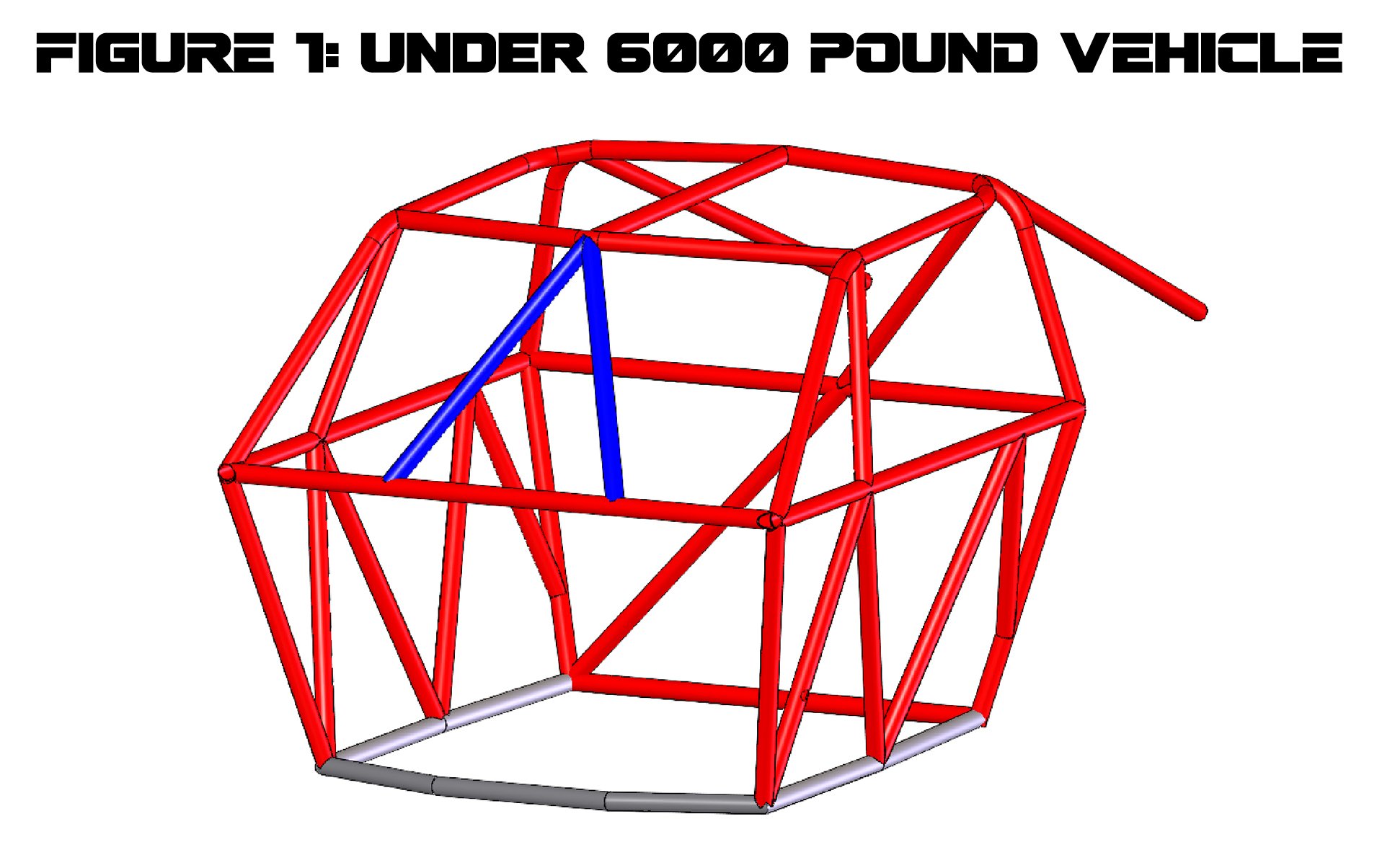
Figure 1: The illustration provided is an example of acceptable cage design.
Actual tube locations may vary from illustration (Locations and sizes subject to American Off-Road Racing Championship approval).
Figure 1: Under 6,000 pound vehicles:
- Red tubes must be size required by weight.
- Blue tubes must be one tube size smaller than required size.

Figure 2: The illustration provided is an example of acceptable cage design.
Actual tube locations may vary from illustration (Locations and sizes subject to American Off-Road Racing Championship approval).
Figure 2: 6000+ Pound Vehicle:
- Red tubes must be 2.000” x 0.120”
- Blue tubes may be 2 standard sizes smaller, diameter or wall thickness, or a combination of the two.
- Tube locations may vary from illustration.
- Locations and sizes subject to American Off-Road Racing Championship approval.
TR35 SAFETY HARNESS
All vehicles must have a heavy-duty type five-point fast release (no push button or quick release type) seat belt and shoulder harness with metal-to-metal buckles and connectors for each occupant. Harnesses must have SFI Foundation's 16.1 or 16.5 labels and expiration date labels. The single anti-submarine strap of the five-point system shall be attached so that it will exert maximum restraint to the upward movement of the belt and harness. The five-point system consists of a 2" seat belt, a 2" anti-submarine belt, and two 2" shoulder straps. No "Y" type shoulder belts. All belts must show the manufacturer's name, month, and year of manufacture. All belts must be changed after three (2) years of date of manufacture. American Off-Road Racing Championship recommends all belts be changed after one (1) year of use. Harness materials shall be nylon or Dacron polyester and in new or perfect condition with no cuts or frayed layers, chemical stains, or excessive dirt.
Shoulder harnesses should be mounted behind the driver/co-driver. The recommended mounting point is approximately 4" below the top of the shoulder. Lap belts should be kept at a minimum at least 2.5" forward of seat and backrest intersection. All belts must be mounted directly to a main structure member of the same size specification as the roll cage and with gussets. All adjustment buckles should be kept at a minimum distance of 1.5" from the seat to prevent accidental loosening or chafing. Mounting hardware must utilize at least 3/8(.375) inch grade 8 steel bolts with 1.5" diameter washers attached through body or frame using lock nuts or cotter key. All belt hardware must be safety wired.
Where slip buckles ("E" rings) are used, they must be doubled up. Example two (2) slip rings per connection.
TR36 SAFETY NETS
Safety nets are mandatory on all enclosed vehicles and must cover the complete open area of side window openings. Safety nets are required with or without side glass and must be labeled SFI 27.1. The net must be fastened every 6 inches around the outside of the net. Fixed corners must be fastened with metal fasteners i.e., hose clamps, Adel clamps, bolts etc. The net border or edge and tie downs shall be made of materials that are as strong or stronger than the netting itself. Acceptable methods of tying the nets into the vehicle include, but are not limited to: hose clamps, snaps, nylon ties, Velcro, metal hooks and steel rods.
Rod must be made from a minimum of 1/2-inch solid steel and go 1 inch through the upper rear mounting tab. 1/2- inch rod top and bottom. No fixed upper rods. • All window net mounts must be welded to the roll cage. The window net, when in closed position, must fit tight and be secured with a safety belt type of latch. Push button latches are not allowed. Spring type mounting of nets on the top or bottom is not permitted.
Nets shall be installed so that the driver and/or co-driver can release the netting and exit the vehicle unassisted regardless of vehicle position. Net installation must meet with the approval of the chief technical inspector.
Netting must be installed on the inside of the roll cage bars so that it will not be damaged or come off the car in the event of a roll-over or slide on the side. All nets must have no more than a 1 inch gap on all borders to contain hands and fingers inside the vehicle. Nets attached to the door frame, or attached to an opening frame covering the entire opening are approved as long as the door/frame is equipped with a secondary latching device.
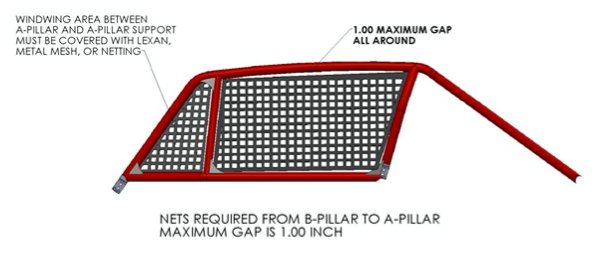
TR37 SEATING
Only seats manufactured for racing will be allowed. All seats must be securely mounted using minimum 3/8(.375) inch grade 8 hardware. Adjustable track type seats must be securely fastened so as to allow no vertical or lateral motion. If stock VW type seat runners are used, they must be clamped to the floor with a minimum of two (2) U-bolts per rail and have 1" diameter washers on the underside. Head and neck restraints are mandatory. Low back seats are not allowed.
GENERAL VEHICLE COMPONENTS
TR38 DRIVER'S COMPARTMENT
Driver and/or co-driver are to enter and exit the driving compartment unassisted with ease, with the vehicle in any position. The driving compartment must be separated by metal firewalls or bulkheads from any acids or fuels. The roof shall also be covered with sheet metal or sheet aluminum (minimum thickness .080 inch) covering all areas. No items inside the driving compartment should be a danger to the occupants, and is subject to Technical Director's approval.
TR39 DOORS and LATCHES
All vehicles with operable doors must have positive locking mechanisms, and must have a secondary latching device.
TR40 FIREWALLS
All vehicles must utilize an all-metal (.040 thick) firewall to separate the driver's compartment from any dangers. Firewalls will keep occupants protected from, fire from the engine and any fuel supplies, any fluids hot or cold. A minimum firewall must extend from the driver's shoulder height to the vehicle floor and body. Maximum gap around any item is 1/16(.062) inch. If rear mounted safety fuel cell is higher than shoulder height, the firewall must be extended at least two inches above the fuel cell.
TR41 BALLAST
Any material used for the purpose of adding weight to meet minimum weight requirements, must be properly attached to the vehicle's structure. Any material added to make minimum weight requirements must also have holes drilled in material so that it may be sealed to a non- removable structure member.
TR42 WEIGHT
Vehicle race weight shall be considered dry weight. (Dry weight is with all fuel tanks drained.) Tools, spare tires, and parts removed, but otherwise the vehicle must be race ready. Official weight will be considered weight shown on official scales.
TR43 FLOORBOARDS
Floorboards or belly pans are required on all vehicles and must be held on by a minimum of six (6) .25" bolts per side if the floor is not an integral part of the body or chassis. Floorboards must cover the entire area from the front of the pedal assembly to the back of the seat(s) and from outside edge to outside edge on the sides. Floorboards will protect occupants from dust and debris.
TR44 BUMPERS and HAZARDOUS PROTRUSIONS
No hazardous front or rear bumpers, nerf bars, frame ends or other protruding objects from the vehicles are allowed. All ends must be rounded and capped off. All vehicles must be equipped with safe front and rear bumpers.
TR45 MIRRORS
A rear-view mirror is required on all. Mirrors are subject to Technical Directors approval.
TR46 SKID PLATES
Skid plates designed to protect the front suspension, steering, and brake components are required on all vehicles. Skid plates must be designed of metal and be securely mounted.
TR47 STORAGE
All spare parts and extra equipment carried on or in a vehicle must be securely fastened to prevent their movement.
TR48 CHASSIS and BODY
All body components shall remain on the vehicle (accidental damage excluded) during the entire event. Body/chassis series must be maintained with body/chassis combinations. as specified in individual class rules.
Fenders must be securely attached to the vehicle if required. The removal of fenders not damaged during the race, after the race has started, will cause the vehicle to be disqualified.
TR49 HOSES
All hoses including metal lines and fittings must be securely clamped and/or safety wired in place.
TR50 IDENTIFICATION MARKINGS
All vehicles in competition must be identified with the correct vehicle number displayed according to the following rules.
All numbers must be displayed on a contrasting background. Number plate background will be distinguishable from the color of the vehicle.
American Off-Road Racing Championship assumes no responsibility for scoring vehicles that have unrecognizable identification numbers. It is the driver's responsibility to keep numbers recognizable at all times during the event.
Four-Wheel Vehicles
- Visible from both sides of the vehicle, one (1) number per side. Numbers must be a minimum of 10" high with a minimum 1" wide stroke.
- Visible from the rear, one (1) number. Numbers must be a minimum of 6" high with a 1" wide stroke.
- Visible from the front, one (1) number upper left Driver's Side visor area. Numbers must be a minimum of 4" high.
- Visible from above, one (1) number. Numbers must be a minimum of 8" high with a 1" wide stroke.
PIT-SUPPORT VEHICLES
All pit-support vehicles will have a minimum 4-inch-high white number of race vehicles on both sides of the vehicle on side windows, on upper passenger-side corner of front windshield and on rear window. Pit support vehicles must have a current American Off-Road Racing Championship pit pass attached to the lower passenger side portion of the front windshield.
TR51 ADVERTISING on VEHICLES
Advertisements may be displayed on vehicles provided they are in good taste and do not interfere with identification marks.
TR52 RADIO EQUIPMENT
Race vehicle/support vehicle radio equipment and or broad casts may not at anytime interfere with Race Communications.
TR53 WORKMANSHIP
All construction, modifications and alterations must be performed in a workmanlike manner. Meet all rules and regulations and is subject to American Off-Road Racing Championship approval.
TR54 TRACKING DEVICE
All vehicles will be mandated to run a GPS tracking/scoring device designated by American Off-Road Racing Championship.
Technical regulations apply to all classes unless otherwise noted in class regulations. Class requirements or safety regulations that are class specific may take precedence over technical regulations.
If class rules specifically state that a modification or optional equipment is allowed, it will be allowed. American Off-Road Racing Championship's intent when prescribing specifications for safety equipment for vehicles/entrants that will compete under American Off-Road Racing Championship rules is to provide protection to all entrants, crew members, officials, and spectators.
American Off-Road Racing Championship does not intend to restrict the general or specific design of any vehicle, but does encourage all entrants to give full attention to safety requirements.
Any deviation from the technical rules at any American Off-Road Racing Championship promoted or sanctioned event will be contingent upon the approval of American Off-Road Racing Championship in writing in advance of the event.
When operating vehicles on the race course, at any time, entrants must use an approved helmet, protective clothing, eye protection, and safety equipment.
SAFETY EQUIPMENT
UTR1 HELMETS
Helmets used in four-wheel vehicles must meet the following requirements:
- Snell memorial foundation, with a legible Snell sticker attached:
- SA2020
- SA2025
- FIA Standard, with a legible with a legible FIA sticker attached:
- 8860-2018
- 8860-2018-ABP
- 8860-2010
- 8859-2024
Youth driver may use SNELL/FIA CM2016.
American Off-Road Racing Championship recommends each helmet be labeled (painted) with the driver/rider’s name, blood type, allergies, or any other medical information. Left hand side of the helmet must be free of all stickers. Straps must have "D" rings, no snaps or Velcro.
As of January 1st 2026, SAH2015, SA2015, FIA 8859-2015 and FIA 8860-2004 helmets will no longer be allowed.
UTR2 PROTECTIVE CLOTHING
4-Wheel Vehicles
Driving suits are required that cover the body from the neck to the ankles and to the wrist. Suits must be manufactured from fire resistant material with the manufacturer's fire-resistant label attached. Suits must be labeled SFI 3.2A/5 or higher. ONE PIECE DRIVING SUITS ARE MANDATORY. Drivers’ suits must be in good condition, clean and free of damage (i.e., holes, tears, rips, etc.) Driving gloves and shoes must meet SFI 3.3 requirements and be free of holes are mandatory. Fire retardant Head sock rated to the SFI 3.3 specification or a helmet skirt rated to the SFI 3.3/5 specification are mandatory. Only cotton undergarments or fire-retardant
long sleeve tops, and long bottom undergarments as well as fire retardant socks rated to the SFI 3.3 specification are allowed.
UTR3 EYE PROTECTION and DENTURES
Shatter resistant eye protection is required for all occupants competing in/on vehicles without full windshields. Those competing in closed cockpit vehicles must have eye protection available in the event the windshield is knocked out or broken.
It is highly recommended that entrants with removable dentures remove them prior to competing in an off-road event.
UTR4 HEAD AND NECK RESTRAINT
All drivers/riders in four (4) wheel vehicles must wear a frontal head restraint (FHR) bearing the SFI, Foundation’s 38.1 manufacturer’s certification label. All head and neck restraints must be replaced or recertified 5 years from date of manufacture. MERU Safety restraints or any restraint using shock absorber will not be allowed.
UTR5 FIRST AID KIT
4-Wheel Vehicles
A suitable, weatherproof, emergency kit composed of individually packaged units must be carried in each vehicle. Each individual unit must contain at least the following items:
(1) - 4" Bandage Compress
(2) - 2" Bandage Compress
(1) - Triangular Bandage
(6) - 2" x 3" Adhesive Pads
(8) - 1" x 3.375" Adhesive Bandages (6) - Prep Pads Treated
(1) - Eye Dressing Packet (5) - Ammonia Inhalants (1) - Ace Bandage
Not required for short course vehicles.
UTR6 EMERGENCY SIGNALING DEVICES
All vehicles must carry a minimum of two emergency warning devices. Two (2) battery-operated red flashing beacons, two large glow sticks or two red reflective devices must be carried in the vehicle. Reflective devices must be at least 12 inches high and 12 inches long and be free standing. American Off-Road Racing Championship stuck stubs are supplied to each entrant at registration. The stuck stub must be kept with the vehicle along with a writing instrument. If a break down or out-of-race condition occurs, the stuck stub must be completed and given to another.
Not required for short course vehicles.
UTR7 HORNS
It is required that all vehicles must be equipped with a loud sounding device. Sirens may be used in addition to horns. Some classes may be required to run collision warning transponders at designated events.
Not required for short course vehicles.
UTR8 REFLECTORS
All vehicles must have either two (2) (four-wheeled Vehicles) 2" minimum diameter red reflectors on the rear of the vehicle and/or helmet. LED lights are not reflective and do not fulfill this rule.
UTR9 FIRE EXTINGUISHER
Each vehicle must have one (1) hand-held portable UL approved 2.5lb minimum ABC rated dry chemical type or halon, AFFF Foam, Novec 1230, FE-36 fire extinguisher equipped with capacity gauge. Fire extinguisher must have a gage and must be fully charged and easily accessible from inside of vehicle.
One(1) minimum 5lb ABC- class, dry chemical fire extinguisher or foam equivalent must be mounted on the exterior of the vehicle. Must be accessible outside of vehicle and mounted to prevent damage to fire extinguisher during rollover. A “On-board fire suppressant” having three (3) nozzles located in these areas, driving compartment, fuel compartment and engine compartment is recommended. All fire extinguishers must be red or white in color, no black extinguishers allowed.
UTR10 SURVIVAL SUPPLIES
All vehicles competing in long course events must carry at least two days of survival supplies and at least one (1) quart of water or other suitable liquid for each occupant/rider.
Not required for short course vehicles.
SUSPENSION COMPONENTS
For classes that have wheel travel limitations the following will apply:
Front wheel travel will be measured at the centerline of the front spindle from metal stop to metal stop. Rear wheel travel will be measured at the centerline of the axle from metal stop to metal stop. Stops will be non-removable and nonadjustable. If limiter straps are to be used for stops the bolts that mount them must be drilled with a minimum 1/8(.125) inch hole so that a American Off-Road Racing Championship may seal them.
UTR11 SHOCK ABSORBERS and BUMP STOPS
At least one shock absorber per wheel, in working condition, must be used on all 4 wheel vehicles. Other systems may be used with prior approval of American Off-Road Racing Championship.
Suspension bump stops must be static and can only be made of rubber, plastic, urethane, etc. In classes that are allowed movable bump stops or secondary suspension, movable stops are allowed.
UTR12 SECONDARY SUSPENSION
Secondary suspension shall include leaf springs, torsion bars, coil over shocks, air bags, air shocks, Haga balls or any other item that changes the wheel rate at any point in its travel other than primary suspension system that was delivered on the vehicle.
Shocks will be considered air shocks/secondary suspension when charged to 200 PSI in its fully extended state and the static shaft pressure exceeds 300 PSI when fully collapsed.
Bump stops will be considered secondary suspension if they contact the suspension unit more than 4" before the end of its travel.
UTR13 WHEELS and TIRES
Snap-on hubcaps or wheel covers of any type are not permitted on any class of vehicle during competition. All rims including spares must be stamped with vehicle race number. Number stamp must be 1/4(.250) inch tall, and be located within two (2) inches of valve stem. Tires will be visually checked for condition and must be considered safe by American Off-Road Racing Championship prior to competing. It is highly recommended that all paint be removed from the mounting surfaces of the rim and the hub.
Maximum tire size is 35" Outside Diameter (O.D.). Pressure checked at 18 PSI on rim to be used.
DOT tire classes are restricted to tires that are intended for highway use. All tires must be designed, built, and sold for use on passenger car, SUV or pickup truck ONLY stamped with D.O.T. number.
UTR14 FASTENERS
All nuts, bolts, and component parts on each vehicle's suspension system, chassis and running gear must be secured with Grade 8 or better nuts and bolts and secured with either lock nut, cotter keys or safety wire and have at least one full thread showing through the nut.
STEERING and BRAKE COMPONENTS
UTR15 STEERING
Steering wheel play must be kept to a minimum. Drag link and tie-rod ends must be secured and keyed. Steering must be considered safe by American Off-Road Racing Championship before the vehicle will be permitted to race.
UTR16 BRAKES
Brakes must be in a safe working condition and able to apply adequate braking force to "Lock-up" all four wheels. Turning or steering brakes are allowed unless allowed by class rules.
ELECTRICAL SYSTEM
UTR17 IGNITION
Each vehicle in competition must have a positive action on-off switch in good working order. The switch must be located within easy reach of the driver and marked or labeled "ignition" ON-Off. All electric fuel pump switches must be labeled as "FUEL" and must be accessible to driver and outside personnel.
UTR18 BATTERIES
Batteries must be securely mounted. All batteries mounted in the driver's compartment must be fully enclosed including the sides and bottom of the battery. Batteries will be considered to be located in the driver's compartment if there is not a full bulkhead (firewall) separating the driver and the battery. Regardless of location battery positive terminal must be insulated.
UTR19 LIGHTS
Four-wheel Vehicles
All four-wheel vehicles must have a minimum of two (2) headlights, two (2) brake lights, and two (2) taillights. Taillights must be mounted at least 48 inches from the ground if other than stock. The brake light must be at least 3" in diameter, or seven square inches.. All UTV's must also have two (2) additional rear facing safety lights. One (1) solid amber and one (1) flashing amber All safety lights must be LED with a minimum of 2000 lumens output. All safety lights must be wired directly to the battery switch. All tail lights must be DOT and in operating condition at all times.
All four-wheel vehicles must have a rearward facing amber colored light. Amber lights must be at least 3” diameter and DOT approved. These lights must be connected to the ignition and remain on during the race. Amber lights must be seen 180° and not blocked by tires or parts. The bulb must be 25 to 55 watts, or LED with equivalent lumens as long as it has an amber colored lens. Light must be mounted at least 48 inches off of the ground. The light must be visible from any position aft of the vehicle and must be protected from damage in case of roll over. A light bar that has all the correct lights may fill these requirements.
Rearward facing lights must be in an operational condition before the vehicle will be allowed to start an event. During an event if the light goes out it must be fixed or replaced at the next available pit location before proceeding in the race. Any light that is connected to a switch that allows the vehicle to move in any direction without the light being on will cause that entry to be disqualified.
Not required for short course vehicles.
UTR20 STARTERS
All vehicles must have a battery and a starter capable of starting the engine.
FUEL SYSTEM
Any of the following commercially available gasoline’s, LPG, or diesel fuel may be used:
- Service station type pump fuel.
- Racing gasoline as manufactured.
- Commercial aviation gasoline.
- Natural or Propane Gas.
- Commercially available Ethanol i.e, E85, C85 or C95 is not allowed. No oxygen bearing fuel including alcohol or nitromethane is allowed. Commercially produced, nationally advertised fuel additives may be used only in the quantities specified by the manufacturer and only if a sample of the gasoline with the additive is supplied for inspection to American Off-Road Racing Championship. Fuel samples may be taken at random before, during, and after the event.
UTR22 FUEL TANKS
Safety fuel cells are required for all classes except some noted UTV classes. Auxiliary fuel tanks may be added to a vehicle in all classes except Class 11. Auxiliary fuel tanks must be safety fuel cells. All fuel cells must be securely mounted, filled with foam and vented to the outside of the vehicle, and have a substantial cross-member between the fuel cell and driver in vehicles with rear mounted cells.
UTV classes that allow a stock fuel tank are required to have the tank and all stock components in the stock location.
No GI cans or fuel containers similar in construction or purpose will be allowed in/on any vehicle during a race. Safety fuel cells shall consist of a bladder enclosed in a metal (minimum of .060 thickness) container as follows:
Bladders shall be constructed of nylon or Dacron woven fabric impregnated and coated with a fuel resistant elastomer. Rotary molded polymer cells are not allowed. The minimum standards acceptable for physical properties are:
| Test Type | Minimum Standard | Test Specification |
| Tensile Strength | 450 lbs. | Spec. CCC-T-1916, Method 5102 |
| Tear Strength | 50 lbs. | Spec. CC-T-1916, Method 5134 |
| Puncture Test | 175 lbs. | Spec. Mil-T-6396, Article 4.5.17 |
These physical properties must be maintained throughout all areas of the finished bladder including seams, joints and fittings.
Container
The bladder shall be fully surrounded in a smooth skinned casing. The container shall be made of .060" Aluminum or steel. Other materials may be approved on request. Use of magnesium prohibited.
UTR23 FUEL FILLER LINES, VENTS, and CAPS
Fuel filler lines and caps must be mounted in a location where they cannot be knocked open or torn off of the vehicle. All fillers must be located within frame or body structure so as to prevent opening or damage during a roll-over or accidental impact. Fuel pick-up openings, lines, breather vents, and fuel filler lines shall be designed and installed not to allow spillage under any conditions. Fuel breather lines must have a check valve and in addition the line must be routed around the fuel cell. Fuel tank breathers must be vented outside the driver's compartment to the rear of the vehicle.
All fuel fillers attached to the frame or body must have a flexible coupling to the tank. Positive locking non-vented fuel filler caps are required. A check valve must be incorporated in the fuel tank to prevent fuel escaping if the cap and filler neck are torn from the tank. All fuel fillers must be surrounded with a splash guard or boot designed to direct spilled fuel to the outside of the vehicle away from the driver, engine, and exhaust system when fueling.
ENGINES, TRANSMISSIONS and DRIVELINES
UTR24 ENGINE and ENGINE DISPLACEMENT
See class rules. Engine location and displacement may be inspected at any time. Engines may be sealed or marked by American Off-Road Racing Championship at any event.
UTR25 ENGINE REPLACEMENT
Engine may be replaced during the event. Entrant must notify American Off-Road Racing Championship that engine is being replaced. Engine replacement must be performed at a designated location.
UTR26 TRANSMISSION
Every vehicle in competition must have a functional reverse.
UTR27 THROTTLES
Every vehicle must have a throttle incorporating two (2) positive action return springs with a minimum pull of two (2) pounds each. A positive stop and override prevention system must be used to keep linkage from passing over center and sticking in an open position. Stock OEM is acceptable.
UTR28 EXHAUST
All vehicles are required to be equipped with forestry approved spark arrestor or with approved mufflers. Exhaust system must be installed to direct the exhaust gases out of the body, rearward, behind the driver, away from the fuel tanks and tires, and placed in such a manner that will minimize the producing of dust. Exhaust pipes must extend at least twelve (12) inches to the rear of the driver's compartment.
UTR29 DRIVE SHAFTS
All front engine vehicles with an open drive shaft must have a retainer hoop securely mounted and located within 6" of the front universal joint. The retainer hoop may consist of either a .25" x 2" steel strap, 2" wide nylon webbing, or .750 diameter tubing. Hoop or strap must be securely attached to a body or frame member.
UTR30 FLYWHEEL SHIELDS
All front engine vehicles with standard transmissions must have a SEMA-approved bell housing or cover. All front engine vehicles with an automatic transmission must have a scatter shield or scatter blanket.
UTR31 FLUID COOLERS
Oil coolers, transmission coolers, and radiators mounted ahead of the driver or in the passenger compartment must have a shroud behind the cooler that will prevent liquids from the cooler or its lines from blowing back onto the driver or co-driver. All hoses that run through the passenger compartment must be shielded.
UTR32 AUXILIARY EQUIPMENT
A generator, fan, water pump (water-cooled engines), and a complete functional electrical system must be connected and in operation at the start of race.
UTR33 SUPERCHARGERS and TURBOCHARGERS
Superchargers and turbochargers are only allowed in those classes noted. Diesel or gasoline engines in stock classes which utilize stock turbochargers may be approved on an individual basis.
VEHICLE SAFETY EQUIPMENT
UTR34 ROLL CAGES
All vehicles must be equipped with a roll cage. Stock UTV cages are not allowed. Minimum design and tubing size based on seamless 4130 chromoly tubing or ASTM 1018/1026 CDS/DOM. All bolt together cage adapters must be welded together. No aluminum or other nonferrous material permitted. A-pillar support tube mandatory.
Material
Material for roll cage construction must be 4130 chromoly tubing or ASTM 1018/1026 CDS/DOM.
All welding must be of the highest quality with full penetration and no undercutting of the parent metal. All welds shall conform to the American Welding Society D1.1, Structural Welding Code, Chapter 10, Tubular Structures and Standards for the material used. It is strongly recommended that the welder inspect all welds using magnetic iron powder or die-penetrate testing.
All tubes must be welded 360-degrees around the circumference of the tube. All bolt together cage adapters must be welded together. No oxy-acetylene brazing or welding allowed.
None of the tubing may show any signs of crimping or wall failure. All bends must be mandrel type. The center radius of the bends may not be less than three (3) times the outside diameter of the roll cage tubing.
Roll Cage Tubing Sizes
For the purposes of determining roll bar tubing sizes, vehicle weight is as raced, but without fuel and driver. Note: There is an allowance of minus 0.010 inches on all tubing thicknesses. Minimum tubing size for the roll cage is:
Up to 2000 lbs: 1.500” x 0.095” Cond N/4130/Seamless or ASTM 1018/1026 CDS/DOM
2001 - 2500 lbs: 1.500” x 0.120” Cond N/4130/Seamless or ASTM 1018/1026 CDS/DOM
2501 - 3000 lbs: 1.750” x 0.095” Cond N/4130/Seamless or ASTM 1018/1026 CDS/DOM
Roll Cage tube size will be determined by the weight of the race vehicle as race ready (sitting on the starting line.) With all spares, tools, etc, full of fuel. Driver and co-drivers are not included in the gross weight.
Construction Procedures
Cages must be securely mounted to the frame or body and gusseted and braced at all points of intersection. Cab or body mounted cages must not be attached to the body structure by direct welding, but must be bolted through and attached by the use of doubler plates (one on either side) with a minimum thickness of 3/16(.187) inch. Where bolt and nuts are used the bolts shall be at least 3/8 (.375) inch diameter SAE Grade 8 or equivalent. Roll cage terminal ends must be located to a frame or body structure that will support maximum impact and not shear. Minimum material dimension requirements for roll cages apply to the following members of the roll cage:
- Front and rear hoop or side lateral tubes
- Front and rear interconnecting bars
- Rear down braces
- Lateral bracing
- Elbow and door bars
- Lower A-pillar tubes, and lower B-pillar tubes
Figure 1: The illustration provided is an example of acceptable cage design.
Actual tube locations may vary from illustration (Locations and sizes subject to American Off-Road Racing Championship approval).
Desert UTV Roll Cage Design (Figure 1):
- Red tubes must be size required by weight.
- Yellow tubes may be one tube size smaller than required size.
All roll cages must be constructed with at least one (1) front hoop (top of cage to floor), one (1) rear hoop (top of cage to floor), or two (2) side lateral hoops, two (2) interconnecting top bars, two (2) rear down braces and one (1) diagonal brace and necessary gussets. If the front and/or rear hoop terminate at elbow/door bar, lower A-pillar and/or B-pillar must be made of the same tubing size as roll cage. Upper main, front, rear, and lateral roll bar hoops must be made in one piece without joints. Centerlines of all required tubes must converge at intersections.
Any vehicle that is not equipped with stock steel doors for driver and co-driver must have sidebars, at least one on each side that will protect the occupants from side impact. Side bars must be parallel to the ground and be located vertically in relation to the occupants to provide maximum protection without causing difficulty in entering or exiting the vehicle. The sidebars must be constructed of tubing of the same material and dimensions as the roll cage. Additional side tubes may be required to limit cockpit intrusion, additional tubes must be of the same size tubing as the roll cage. Tubes must be placed in such a manner as to limit openings adjacent to the occupants. Maximum opening size in this area is limited to 370 square inches.
All roll cage bars must be at least 3” in any direction from the driver and co-driver’s helmets in their normal driving positions.
Gussets must be installed at all main intersections on the main cage including diagonal and rear down braces, and where single weld fractures can affect driver’s safety. Gussets may be constructed of .125” X 3” X 3” flat plate, split, formed and welded corner tubing, or tubing gussets the same thickness as the main cage material. Rear down braces and diagonal braces must angle no less than 30 degrees from vertical.
Head/neck restraints designed to prevent whiplash are required on all vehicles. These restraints must be a headrest of approximately 36 square inches, with a resilient padding at least 2” thick. Any portion of the roll bar or bracing which might come in contact with the helmet must be padded.

Figure 3: The illustration provided is an example of acceptable cage design.
Actual tube locations may vary from illustration (Locations and sizes subject to American Off-Road Racing Championship approval).
Youth 1000/570 UTV (Figure 3):
Minimum roll cage tubing diameter and thickness requirements are shown in the drawings at the end of the UTV class rules. Minimum tubing diameter and thickness are:
- Red tubes are required to have a minimum of 1.5” x .095” tubing
- Blue tubes are required to have a minimum of 1.5” x .095” tubing
- Yellow tubes are required to have a minimum of 1.25” x .095” tubing
1 ½ inch x .095 inch minimum 4130 Chromoly or DOM tubing is required for the main roll cage.
2-seat cars: Top of roll cage above driver’s head must have either an ‘X’ or a front to back center bar with a single diagonal above the driver’s head
RS1 cars: Top of roll cage above the driver’s head must have a diagonal brace.

Figure 4: The illustration provided is an example of acceptable cage design.
Actual tube locations may vary from illustration (Locations and sizes subject to American Off-Road Racing Championship approval).
RZR 170/200/250 (Figure 4):
Minimum tubing diameter and thickness are:
- Red tubes are required to have a minimum of 1.25” x 095” tubing
- Blue tubes are required to have a minimum of 1.25” x .083” tubing
- Yellow tubes are required to have a minimum of 1” x .083” tubing
Minimum roll cage tubing diameter and thickness requirements are shown in the drawings at the end of the UTV class rules.
Top of the roll cage above the driver's head must have either an ‘X’ or a front to back center bar.
UTR35 SAFETY HARNESS
All vehicles except Motorcycles and ATV's must have a heavy-duty type five-point fast release (no push button or quick release type) seat belt and shoulder harness with metal-to-metal buckles and connectors for each occupant. Harnesses must have SFI Foundation's 16.1 or 16.5 labels and expiration date labels. The single antisubmarine strap of the five-point system shall be attached so that it will exert maximum restraint to the upward movement of the belt and harness. The five-point system consists of a 2" seat belt, a 2" antisubmarine belt, and two 2" shoulder straps. No "Y" type shoulder belts. All belts must show manufacturer's name, month, and year of manufacture. All belts must be changed after three (2) years of date of manufacture. American Off-Road Racing Championship recommends all belts be changed after one (1) year of use. Harness materials shall be nylon or Dacron polyester and in new or perfect condition with no cuts or frayed layers, chemical stains, or excessive dirt.
Shoulder harness should be mounted behind the driver/co-driver. The recommended mounting point is approximately 4" below the top of the shoulder. Lap belts should be kept at a minimum at least 2.5" forward of seat and backrest intersection. All belts must be mounted directly to a main structure member of the same size specification as the roll cage and with gussets. All adjustment buckles should be kept at a minimum distance of 1.5" from the seat to prevent accidental loosening or chafing. Mounting hardware must utilize at least 3/8(.375) inch grade 8 steel bolts with 1.5" diameter washers attached through body or frame using lock nuts or cotter key. All belt hardware must be safety wired.
Where slip buckles ("E" rings) are used, they must be doubled up. Example two (2) slip rings per connection.
UTR36 SAFETY NETS
Safety nets are mandatory on all enclosed vehicles and must cover the complete open area of side window openings. Safety nets are required with or without side glass and must be labeled SFI 27.1. The net must be fastened every 6 inches around the outside of the net. Fixed corners must be fastened with metal fasteners i.e., hose clamps, Adel clamps, bolts etc. The net border or edge and tie downs shall be made of materials that are as strong or stronger than the netting itself. Acceptable methods of tying the nets into the vehicle include, but are not limited to: hose clamps, snaps, nylon ties, Velcro, metal hooks and steel rods.
Rod must be made from a minimum of 1/2-inch solid steel and go 1 inch through the upper rear mounting tab. 1/2- inch rod top and bottom. No fixed upper rods. • All window net mounts must be welded to the roll cage. The window net, when in closed position, must fit tight and be secured with a safety belt type of latch. Push button latches are not allowed. Spring type mounting of nets on the top or bottom is not permitted.
Nets shall be installed so that the driver and/or co-driver can release the netting and exit the vehicle unassisted regardless of vehicle position. Net installation must meet with the approval of the chief technical inspector.
Netting must be installed on the inside of the roll cage bars so that it will not be damaged or come off the car in the event of a roll-over or slide on the side. All nets must have no more than a 1inch gap on all borders to contain hands and fingers inside the vehicle. Nets attached to the door frame, or attached to an opening frame covering the entire opening are approved as long as the door/frame is equipped with a secondary latching device.

UTR37 SEATING
Only seats manufactured for racing will be allowed. All stock seats must be removed. All seats must be securely mounted using minimum 3/8(.375) inch grade 8 hardware. Adjustable track type seats must be securely fastened so as to allow no vertical or lateral motion. If stock type seat runners are used, they must be clamped to the floor with a minimum of two (2) U-bolts per rail and have 1" diameter washers on the underside. Head and neck restraints are mandatory. Low back seats are not allowed.
GENERAL VEHICLE COMPONENTS
UTR38 DRIVER'S COMPARTMENT
Driver and/or co-driver are to enter and exit the driving compartment unassisted with ease, with the vehicle in any position. The driving compartment must be separated by firewalls or bulkheads from any acids or fuels. The roof shall also be covered with sheet metal or sheet aluminum (minimum thickness .080 inch) covering all areas. No items inside the driving compartment should be a danger to the occupants, and is subject to Technical Director’s approval.
UTR39 DOORS and LATCHES
All vehicles with operable doors must have positive locking mechanisms, and must have a secondary latching device.
UTR40 FIREWALLS
All vehicles must utilize an all-metal firewall to separate the driver's compartment from any dangers. Firewalls will keep occupants protected from, fire from the engine and any fuel supplies, any fluids hot or cold. A minimum firewall must extend from the driver's shoulder height to the vehicle floor and body. Maximum gap around any item is 1/16(.062) inch. If rear mounted safety fuel cell is higher than shoulder height, the firewall must be extended at least two inches above the fuel cell.
UTR41 BALLAST
Any material used for the purpose of adding weight to meet minimum weight requirements, must be properly attached to the vehicle's structure. Any material added to make minimum weight requirements must also have holes drilled in material so that it may be sealed to a non- removable structure member.
UTR42 WEIGHT
Vehicle race weight shall be considered dry weight. (Dry weight is with all fuel tanks drained.) Tools, spare tires, and parts removed, but otherwise the vehicle must be race ready. Some classes are wet weight including driver. Official weight will be considered weight shown on official scales.
UTR43 FLOORBOARDS
Floorboards or belly pans are required on all vehicles and must be held on by a minimum of six (6) .25" bolts per side if the floor is not an integral part of the body or chassis. Floorboards must cover the entire area from the front of the pedal assembly to the back of the seat(s) and from outside edge to outside edge on the sides. Floorboards will protect occupants from dust and debris.
UTR44 BUMPERS and HAZARDOUS PROTRUSIONS
No hazardous front or rear bumpers, nerf bars, frame ends or other protruding objects from the vehicles are allowed. All ends must be rounded and capped off. No sharp corners or hazardous protrusions. All vehicles must be equipped with safe front and rear bumpers.
UTR45 MIRRORS
A rear-view mirror is required on all. Mirrors are subject to Technical Directors approval.
UTR46 SKID PLATES
Open. Skid plates designed to protect the front suspension, steering, and brake components are required on all vehicles. Skid plates must be designed of metal and be securely mounted.
UTR47 STORAGE
All spare parts and extra equipment carried on or in a vehicle must be securely fastened to prevent their movement.
UTR48 CHASSIS and BODY
All body components shall remain on the vehicle (accidental damage excluded) during the entire event. Body/chassis series must be maintained with body/chassis combinations. as specified in individual class rules.
Fenders must be securely attached to the vehicle if required. The removal of fenders not damaged during the race, after the race has started, will cause the vehicle to be disqualified.
UTR49 HOSES
All hoses including metal lines and fittings must be securely clamped and/or safety wired in place.
UTR50 IDENTIFICATION MARKINGS
American Off-Road Racing Championship will assign race numbers.
All vehicles in competition must be identified with the correct vehicle number displayed according to the following rules.
All numbers must be displayed on a contrasting background. Number plate background will be distinguishable from the color of the vehicle.
Sportsman classes must have black numbers on a yellow background.
American Off-Road Racing Championship assumes no responsibility for scoring vehicles that have unrecognizable identification numbers. It is the driver's responsibility to keep numbers recognizable at all times during the event.
Four-wheel Vehicles
- Visible from both sides of the vehicle, one (1) number per side. Numbers must be a minimum of 10" high with a minimum 1" wide stroke.
- Visible from the rear, one (1) number. Numbers must be a minimum of 6" high with a 1" wide stroke.
- Visible from the front, one (1) number upper left Driver's Side visor area. Numbers must be a minimum of 4" high.
- Visible from above, one (1) number. Numbers must be a minimum of 8" high with a 1" wide stroke.
PIT-SUPPORT VEHICLES
All pit-support vehicles will have a minimum 4-inch high white number of race vehicle on both sides of vehicle on side windows, on upper passenger-side corner of front windshield and on rear window. Pit support vehicles must have a current American Off-Road Racing Championship pit pass attached to lower passenger side portion of the front windshield.
UTR51 ADVERTISING on VEHICLES
Advertisements may be displayed on vehicles provided they are in good taste and do not interfere with identification marks.
UTR52 RADIO EQUIPMENT
Race vehicle/support vehicle radio equipment and or broad casts may not at anytime interfere with Race Communications.
UTR53 WORKMANSHIP
All construction, modifications and alterations must be performed in a workmanlike manner. Meet all rules and regulations and is subject to American Off-Road Racing Championship approval.
UTR54 TRACKING DEVICE
All vehicles will be mandated to run a GPS tracking/scoring device designated by American Off-Road Racing Championship.
Technical regulations apply to all classes unless otherwise noted in class regulations. Class requirements or safety regulations that are class specific may take precedence over technical regulations.
If class rules specifically state that a modification or optional equipment is allowed, it will be allowed. American Off-Road Racing Championship's intent when prescribing specifications for safety equipment for vehicles/entrants that will compete under American Off-Road Racing Championship rules is to provide protection to all entrants, crew members, officials, and spectators.
American Off-Road Racing Championship does not intend to restrict the general or specific design of any vehicle, but does encourage all entrants to give full attention to safety requirements.
Any deviation from the technical rules at any American Off-Road Racing Championship promoted or sanctioned event will be contingent upon the approval of American Off-Road Racing Championship in writing in advance of the event.
When operating vehicles on the race course, at any time, entrants must use an approved helmet, protective clothing, eye protection, and safety equipment.
SAFETY EQUIPMENT
MTR1 HELMETS
Motorcycle and ATV’s must meet the following requirements:
- Snell memorial foundation, with a legible Snell sticker attached:
- M2020D
- M2020R
- M2025D
- M2025R
- FIA standard, with a legible sticker attached:
- 8860-2018
- 8860-2018-ABP
- 8860-2010
- 8859-2024
- ECE 22-05
- ECE 22-06
American Off-Road Racing Championship recommends each helmet be labeled (painted) with the driver/rider’s name, blood type, allergies, or any other medical information. Left hand side of the helmet must be free of all stickers. Straps must have "D" rings, no snaps or Velcro.
As of January 1st 2026, M2015, FIA 8860-2004, FIA 8859-2015 helmets will no longer be allowed.
MTR2 PROTECTIVE CLOTHING
Full-length boots, gloves, goggles, shoulder pads, chest protectors, and padded trousers are required items.
MTR3 EYE PROTECTION and DENTURES
Shatter resistant eye protection is required for all occupants competing in/on vehicles without full windshields. Those competing in closed cockpit vehicles must have eye protection available in the event the windshield is knocked out or broken.
It is highly recommended that entrants with removable dentures remove them prior to competing in an off-road event.
MTR5 FIRST AID KIT
Each rider must carry a suitable, weatherproof, emergency kit composed of individually packaged units. Each individual unit must contain at least the following items:
(1) - 4" Bandage Compress
(1) - Eye Dressing Packet
(8) - 2" x 3" Adhesive Pads
(8) - 1" x 3.375" Bandages
(1) - 8cc Antiseptic
MTR8 REFLECTORS
All vehicles must have 1 Motorcycles and Quads 2" minimum diameter red reflectors on the rear of the vehicle and/or helmet. LED lights are not reflective and do not fulfill this rule.
MTR10 SURVIVAL SUPPLIES
All vehicles competing in long course events must carry at least two days of survival supplies and at least one (1) quart of water or other suitable liquid for each occupant/rider.
Not required for short course vehicles.
SUSPENSION COMPONENTS
MTR14 FASTENERS
All nuts, bolts, and component parts on each vehicle's suspension system, chassis and running gear must be secured with Grade 8 or better nuts and bolts and secured with either lock nut, cotter keys or safety wire and have at least one full thread showing through the nut.
STEERING and BRAKE COMPONENTS
MTR15 STEERING
Steering must be considered safe by American Off-Road Racing Championship before the vehicle will be permitted to race.
MTR16 BRAKES
Brakes must be in a safe working condition and able to apply adequate braking force to "Lock-up" both wheels.
ELECTRICAL SYSTEM
MTR17 IGNITION
Each vehicle in competition must have a positive action on-off switch in good working order. The switch must be located within easy reach of the rider and marked or labeled "ignition" ON-Off.
MTR18 BATTERIES
Batteries must be securely mounted. Regardless of location, the battery positive terminal must be insulated.
MTR19 LIGHTS
All Motorcycles and Quads must also have a minimum of one (1) headlight and one (1) taillight. Headlights are only required if racing after sunset or before sunrise. All lights must be in operating condition at all times. Taillights must be on during the entire race. Tail light must be either powered by the Motorcycle or Quad AC generating system or be a American Off-Road Racing Championship approved battery powered unit capable of operating for the entire event.
FUEL SYSTEM
MTR21 FUEL
Any of the following commercially available gasoline’s, LPG, or diesel fuel may be used:
- Service station type pump fuel.
- Racing gasoline as manufactured.
- Commercial aviation gasoline.
- Natural or Propane Gas.
- Commercially available Ethanol i.e., E85, C85 or C95 is allowed. No oxygen bearing fuel including alcohol or nitromethane is allowed. Commercially produced, nationally advertised fuel additives may be used only in the quantities specified by the manufacturer and only if a sample of the gasoline with the additive is supplied for inspection to American Off-Road Racing Championship. Fuel samples may be taken at random before, during, and after the event.
MTR22 FUEL TANKS
MTR23 FUEL FILLER LINES, VENTS, and CAPS
Fuel filler lines and caps must be mounted in a location where they cannot be knocked open or torn off of the vehicle. Fuel pick-up openings, lines, breather vents, and fuel filler lines shall be designed and installed not to allow spillage under any conditions. Fuel breather lines must have a check valve and in addition the line must be routed around the fuel cell.
Positive locking fuel filler caps are required.
ENGINES, TRANSMISSIONS and DRIVELINES
MTR24 ENGINE and ENGINE DISPLACEMENT
See class rules. Engine location and displacement may be inspected at any time. Engines may be sealed or marked by American Off-Road Racing Championship at any event.
MTR25 ENGINE REPLACEMENT
Engine may be replaced during the event. Entrant must notify American Off-Road Racing Championship that engine is being replaced. Engine replacement must be performed at a designated location.
MTR26 TRANSMISSION
MTR27 THROTTLES
MTR28 EXHAUST
All vehicles are required to be equipped with forestry approved spark arrestor or with approved mufflers. Exhaust system must be installed to direct the exhaust gases rearward, behind the rider, away from the fuel tanks and tires, and placed in such a manner that will minimize the production of dust.
MTR31 FLUID COOLERS
Oil coolers, transmission coolers, and radiators mounted ahead of the rider must have a shroud behind the cooler that will prevent liquids from the cooler or its lines from blowing back onto the rider.
MTR32 AUXILIARY EQUIPMENT
MTR49 HOSES
All hoses including metal lines and fittings must be securely clamped and/or safety wired in place.
MTR50 IDENTIFICATION MARKINGS
- Visible from the side, one (1) number per side on both sides of the rear wheel. Numbers must be a minimum of 6" high with a minimum 1" stroke width and attached to a number plate of sufficient size to accommodate them.
- Visible from the front, one (1) number. Numbers must be a minimum of 6" high with a 1" stroke width and attached to a number plate of sufficient size to accommodate them.
- A blank space (21⁄2" high by 8" width minimum) anywhere on the vehicle must be left.
- Any letters used for identification purposes by American Off-Road Racing Championship in your number may be 1/2 the size of the number.
PIT-SUPPORT VEHICLES
All pit-support vehicles will have a minimum 4-inch-high white number of race vehicles on both sides of the vehicle on side windows, on upper passenger-side corner of front windshield and on rear window. Pit support vehicles must have a current American Off-Road Racing Championship pit pass attached to the lower passenger side portion of the front windshield.
MTR51 ADVERTISING on VEHICLES
Advertisements may be displayed on vehicles provided they are in good taste and do not interfere with identification marks.
MTR52 RADIO EQUIPMENT
Race vehicle/support vehicle radio equipment and or broad casts may not at anytime interfere with Race Communications.
MTR53 WORKMANSHIP
All construction, modifications and alterations must be performed in a workmanlike manner. Meet all rules and regulations and is subject to American Off-Road Racing Championship approval.
MTR54 TRACKING DEVICE
All vehicles will be mandated to run a GPS tracking/scoring device designated by American Off-Road Racing Championship.
American Off-Road Racing Championship has opened up the availability of motors in all limited engine classes to create a more competitive atmosphere for both performance and pricing.
All of the following motors have been approved by American Off-Road Racing Championship to compete:
- Turnkey Engines
- Redline Performance
- Wiks Racing Engine
- Roush Competition Engines
- Danzio Performance
- Lozano Performance
- CBM Motorsports
- Major Performance
- Dougans Racing Engines
- Moruzzi Race Motors
Sealed GM LS3 or GM 525RLB engine rebuilders:
- Wiks Racing Engines
- Roush Competition Engines
- Klein Engines
Any other engine builders interested please contact us at tech@unlimitedoffroadracing.com
2026 AORC Class Regulations:
The TR abbreviations listed under this class (I.E. TR1 HELMETS) refer to TR cross reference listings in the front of this book. These TR cross-referenced listings are part of the class rules. Where a conflict occurs between the TR cross-referenced listing and a rule contained under this class, the rule contained under this class takes priority.
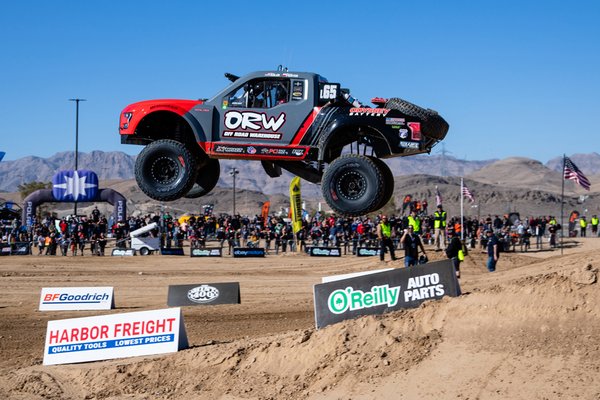
Unlimited Truck Legends
L01 - L99
Unlimited vehicles with truck or SUV body. Drivers over the age of 50.

Class 1 SPEC / 6200
6200 - 6299
Unlimited 4 wheel, single and two seat vehicles. Limited to IRS. No straight axle suspension.

Pre-Runner Class
P001 - P299
This class is only available at The Mint 400 and open to all Driver of Records racing in the Unlimited Race on Saturday.
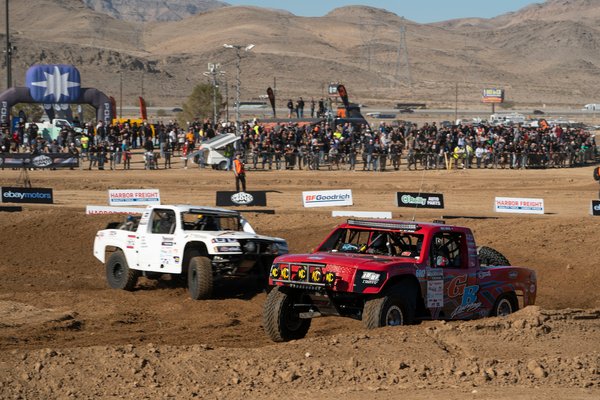
TrophyLite
6000 - 6099
Purpose built SPEC race truck, 4 cylinder engine, SPEC suspension, parts and bodies.
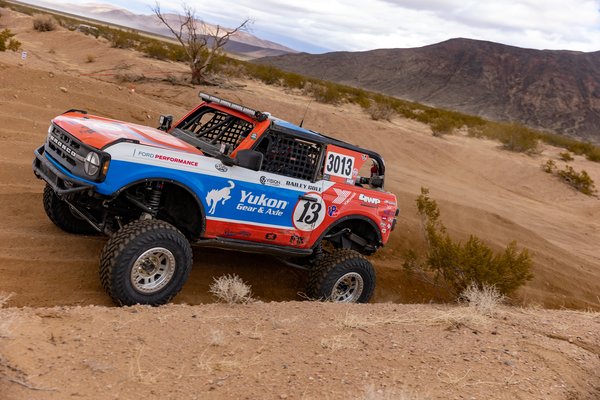
Class 3000
3000 - 3099
Limited two(2) or three(3) seat mini or mid-sized vehicle. Engine is limited to sealed SPEC.
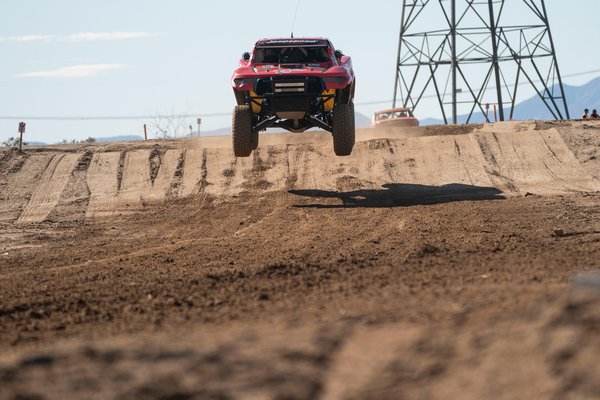
Jeepspeed Trophy
4700 - 4799
Identical to Jeepspeed Outlaws but with open class specific exceptions.
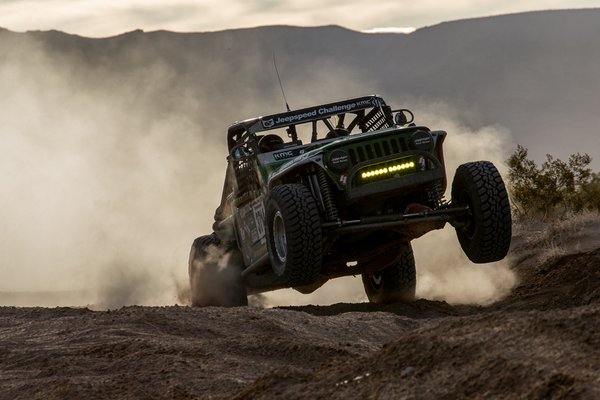
Jeepspeed Outlaws
3700 - 3799
Jeep or Dodge sport utility vehicles and light trucks with original frame.

Class 2000
2000 - 2099
Production mini or full-size truck. Production steel body and doors must be used.
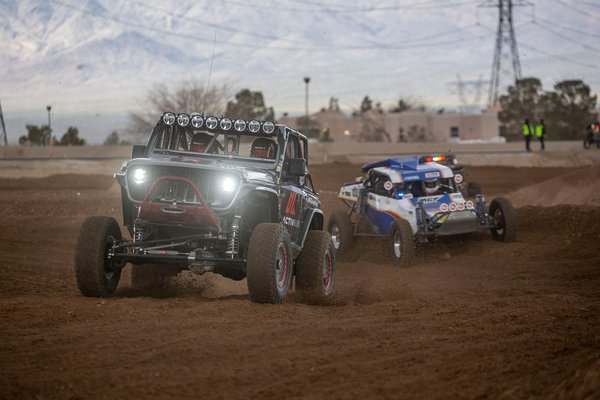
Jeepspeed Cup
2700 - 2799
Jeep and Dodge vehicles that maintain the original appearance and profile.

Modern Vintage
V300 - V399
Vintage Trucks, Buggies and Heavy Metal Vehicles built/raced before and including 1995.
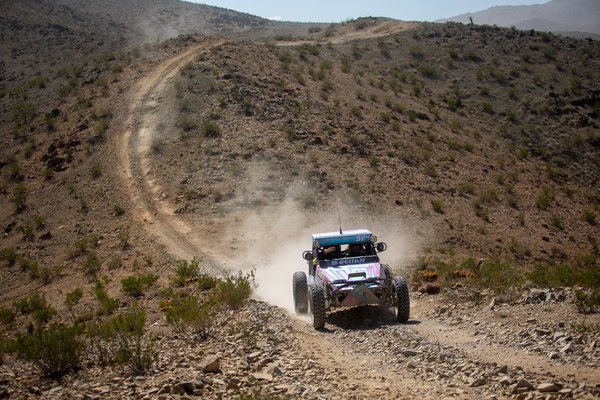
Class 9 Challenger
900 - 999
Single and two seat vehicles with a maximum wheelbase of 100". Vehicle parts are based on a Type I VW.

Scrambler Sportsman Motorcycle
SC01 - SC99
750cc or larger, Max 2 Riders. Ducati Scrambler, Triumph Scrambler, Indian FTR Scrambler and HD Pan America.
| Class Name | Numbers | Category | Class Description |
|---|---|---|---|
| Unlimited Truck (4WD) | 1-99 | Car/Truck | Four-Wheel Drive Unlimited vehicles with truck or SUV body. |
| Unlimited Truck (2WD) | 1 - 99 | Car/Truck | Two-Wheel Drive Unlimited vehicles with truck or SUV body. |
| Class 1 Unlimited | 100U-199U | Car/Truck | Unlimited Two or Four Wheel Drive Open Wheel Vehicle |
| Class 1 | 100-199 | Car/Truck | Unlimited open wheel vehicles |
| Unlimited Truck SPEC | 200 - 299 | Car/Truck | Unlimited chassis and suspension truck or SUV with limited engine. |
| Unlimited Truck Legends | L1-L99 | Car/Truck | Unlimited vehicles with truck or SUV body. Drivers over the age of 50. |
| Class 1 SPEC / 6200 | 6200 - 6299 | Car/Truck | Unlimited 4 wheel, single and two seat vehicles. Limited to IRS. No straight axle suspension. |
| Class 8 | 800 - 849 | Car/Truck | Limited Full Size truck or SUV |
| R400: Unlimited | 4400 - 4499 | Rock | Unlimited |
| Class 7 | 700 - 799 | Car/Truck | Unlimited chassis Mini or Mid size truck or SUV. Maximum six cylinder engine. |
| Pre-Runner Class | PR1 - PR299 | Car/Truck | This class is only available at The Mint 400 and open to all Driver of Records racing in the Unlimited Race on Saturday. |
| UTV Pro | T1 - T999 | UTV Desert | Maximum engine size: 2000cc NA, 1000cc Turbo |
| Super 10 | S1000 - S1099 | Super 10 | |
| Class 10 | 1000 - 1099 | Car/Truck | Unlimited open wheel vehicles with limited engine. |
| UTV Pro Turbo | B1 - B999 | UTV Desert | Non R/H2 vehicles. Maximum engine size: 1000cc Turbo, 40mm max |
| UTV Pro NA | R1 - R999 | UTV Desert | Non R/H2 vehicles. Maximum engine size: 1000cc NA |
| UTV Pro Stock Modified | Z1-Z999 | UTV Desert | Maximum engine size: 2000cc NA, 1000cc Turbo |
| UTV Pro Stock | S1-S999 | UTV Desert | Maximum engine size: 2000cc NA, 1000cc Turbo |
| R900: Pro Open UTV | O4900 - O4999 | UTV Rock | Open UTV |
| R900: Pro Modified UTV | M4900 - M4999 | UTV Rock | Pro Modified UTV |
| Class 5 Unlimited | 500 - 549 | Car/Truck | Unlimited Baja Bug |
| TrophyLite | 6000 - 6099 | Car/Truck | Purpose built SPEC race truck, 4 cylinder engine, SPEC suspension, parts and bodies. |
| Class 3000 | 3000 - 3099 | Car/Truck | Limited two(2) or three(3) seat mini or mid-sized vehicle. Engine is limited to sealed SPEC. |
| Class 12 | 1200 - 1299 | Car/Truck | Limited Open Wheel Vehicle |
| 1/2 1600 | 1600 - 1699 | Car/Truck | Limited chassis, limited engine open wheel vehicle. |
| Jeepspeed Trophy | 4700 - 4799 | Car/Truck | Identical to Jeepspeed Outlaws but with open class specific exceptions. |
| Jeepspeed Outlaws | 3700 - 3799 | Car/Truck | Jeep or Dodge sport utility vehicles and light trucks with original frame. |
| Class 1450 | 1400 - 1499 | Car/Truck | Open production full sized or mini truck. Must have production steel body. |
| Class 2000 | 2000 - 2099 | Car/Truck | Production mini or full-size truck. Production steel body and doors must be used. |
| UTV Stock Modified | UM900-UM999 | UTV Desert | Maximum engine size: 2000cc NA, 1000cc Turbo |
| UTV Stock | U1 - U999 | UTV Desert | Non R/H2 vehicles. Maximum engine size: 1000cc NA or Turbo, 40mm max |
| UTV Sportsman | US1 - U999 | UTV Desert | Maximum engine size: 2000cc NA, 1000cc Turbo |
| R900: UTV Stock | S4900 - S4999 | UTV Rock | Stock |
| UTV EV/Hybrid | E1 - E999 | UTV Desert | Non R/H2 vehicles. Must be EV or Hybrid |
| Class 7F | 700F - 739F | Car/Truck | Class rules coming soon... |
| Class 7S | 7100 - 7199 | Car/Truck | Limited Mini or Mid size truck or SUV Sportsman |
| Jeepspeed Cup | 2700 - 2799 | Car/Truck | Jeep and Dodge vehicles that maintain the original appearance and profile. |
| Jeepspeed Challenge | 1700 - 1799 | Car/Truck | Short wheel base Jeeps with 6 Cylinder and 4 cylinder engines. |
| R500: Modified | 4500 - 4599 | Rock | Modified |
| R600: Stock Class | 4600 - 4699 | Rock | Stock |
| R800: Legends | 4800 - 4899 | Rock | Legends |
| 5-1600 | 550 - 599 | Car/Truck | Limited Baja Bug |
| Modern Vintage | V300 - V399 | Car/Truck | Vintage Trucks, Buggies and Heavy Metal Vehicles built/raced before and including 1995. |
| Vintage Open | V200 - V299 | Car/Truck | Race cars 1989 and older. |
| Vintage | V100 - V199 | Car/Truck | Race cars 1982 and older. |
| Stock Production Truck Mini/Mid | 7300 - 7399 | Car/Truck | Stock Production Mini or Mid size truck or SUV. |
| Stock Production Truck Full | 850 - 899 | Car/Truck | Stock Production Full size truck or SUV |
| Open Sportsman | 8100 - 8199 | Car/Truck | Unlimited Vehicle Sportsman Class. |
| Class 9 Challenger | 900 - 999 | Car/Truck | Single and two seat vehicles with a maximum wheelbase of 100". Vehicle parts are based on a Type I VW. |
| Class 11 | 1100 - 1199 | Car/Truck | Stock Production VW Bug |
| EV Unlimited | EV300 - EV399 | Car/Truck | Open EV |
| EV Open Production | EV200 - EV299 | Car/Truck | Open Production EV Truck/SUV |
| EV Production | EV100 - EV199 | Car/Truck | Stock Production EV Truck/SUV |
| Hybrid Unlimited | H300 - H399 | Car/Truck | Open Hybrid |
| Hybrid Open Production | H200 - H299 | Car/Truck | Open Production Hybrid Truck/SUV |
| Hybrid Production | H100 - H199 | Car/Truck | Stock Production Hybrid Truck/SUV |
| Modern Military | M1 - M99 | Car/Truck | TBD |
| Vintage Military | M100 - M199 | Car/Truck | TBD |
| Gambler 500/Hooptie X Modified | G01 - G99 | Car/Truck | Modified Gambler 500/Hooptie X vehicle |
| Open Pro Motorcycle | N1 - N99 | Motorcycle | Open |
| 399 Pro Motorcycle | X1 - X99 | Up to 399cc | |
| Lites Pro Motorcycle | A1 - A99 | Up to 250cc | |
| Ironman Pro Motorcycle | J1 - J99 | Open | |
| Over 30 Pro Motorcycle | P1 - P99 | Open | |
| Over 40 Pro Motorcycle | C1 - C99 | Open | |
| Quad Pro | Q1 - Q99 | Open | |
| Open Expert Motorcycle | 301 - 350 | Open | |
| 399 Expert Motorcycle | X101 - X199 | Up to 399cc | |
| Lites Expert Motorcycle | K101 - K150 | Up to 250cc | |
| Ironman Expert Motorcycle | O1 - O50 | Open | |
| Over 30 Expert Motorcycle | M501 - M599 | Open | |
| Over 40 Expert Motorcycle | M701 - M799 | Open | |
| Over 50 Expert Motorcycle | M801 - M899 | Open | |
| Over 60 Expert Motorcycle | M901 - M999 | Open | |
| Women’s Expert Motorcycle | W1 - W99 | Open | |
| Family Expert Motorcycle | F1 - F99 | Open | |
| Quad Expert | 401 - 450 | Open | |
| Quad IM Expert | 601 - 699 | Open | |
| Open Amateur Motorcycle | 351 - 399 | Open | |
| 399 Amateur Motorcycle | X201 - X299 | Up to 399cc | |
| Ironman Amateur Motorcycle | O51 - O99 | Open | |
| EV Motorcycle | EM1 - EM99 | Motorcycle | EV, Max 3 Riders |
| 1974 & Down Sportsman Motorcycle | VM1 - VM99 | Motorcycle | Any cc, Max 2 Riders |
| 1975-1982 Sportsman Motorcycle | VM100 - VM199 | Motorcycle | Any cc, Max 2 Riders |
| 1983-1995 Sportsman Motorcycle | VM200 - VM299 | Motorcycle | Any cc, Max 2 Riders |
| Scrambler Sportsman Motorcycle | SC01 - SC99 | Motorcycle | 750cc or larger, Max 2 Riders. Ducati Scrambler, Triumph Scrambler, Indian FTR Scrambler and HD Pan America. |
| Hooligan Sportsman Motorcycle | H01 - H99 | Motorcycle | 750cc or larger, Max 2 Riders. Harley Sportster only. |
| Adventure Bike Sportsman Motorcycle | AB1 - AB99 | Motorcycle | 640cc & Up, Max 2 Riders |
| Youth 1000 | Y1000 - Y1999 | Youth | Limited Youth Normally Aspirated 1000 UTV |
| Youth 570 | Y500 - Y599 | Youth | Youth 570cc UTV |
| Youth 250 | Y200 - Y299 | Youth | Unlimited Youth 250 UTV |
| Youth 200 | L200 - L299 | Youth | Limited Youth 200 UTV |
| Youth 170 Open | YO1 - YO199 | Youth | Limited Youth 170 UTV |
| Youth 170 Production | Y1 - Y199 | Youth | 2026 ruleset will publish Monday, October 27th at 5pm PST |

